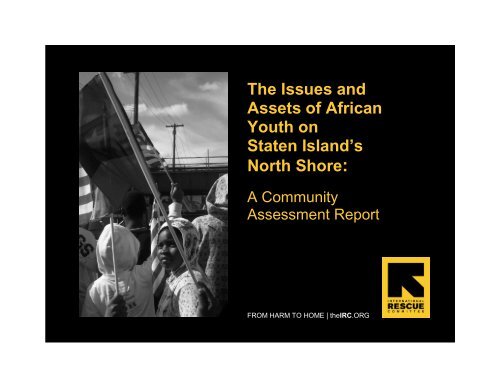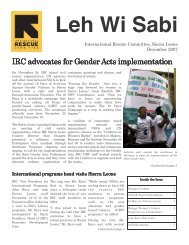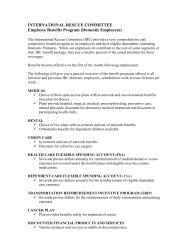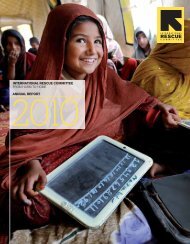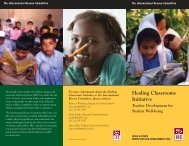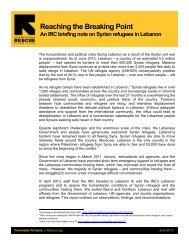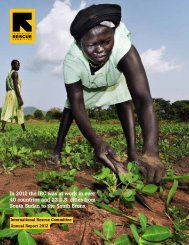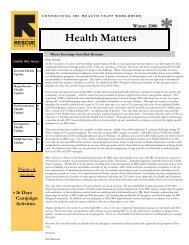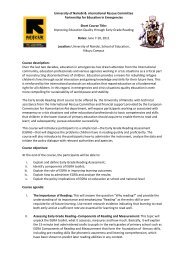The Issues and Assets of African Youth on Staten Island's North Shore:
The Issues and Assets of African Youth on Staten Island's North Shore:
The Issues and Assets of African Youth on Staten Island's North Shore:
- No tags were found...
You also want an ePaper? Increase the reach of your titles
YUMPU automatically turns print PDFs into web optimized ePapers that Google loves.
have, <str<strong>on</strong>g>and</str<strong>on</strong>g> designing research tools (including body mapping,interviews, role playing, group discussi<strong>on</strong>, mapping,carto<strong>on</strong>ing, <str<strong>on</strong>g>and</str<strong>on</strong>g> a survey) they planned an event called“Taking a St<str<strong>on</strong>g>and</str<strong>on</strong>g>” for August 2, 2008. <str<strong>on</strong>g>The</str<strong>on</strong>g> group marketedthe event to youth ages 10 to 21 through flyers, a MySpacepage, <str<strong>on</strong>g>and</str<strong>on</strong>g> word <str<strong>on</strong>g>of</str<strong>on</strong>g> mouth. Though rain fell the day <str<strong>on</strong>g>of</str<strong>on</strong>g> theevent, 24 youth participated. <str<strong>on</strong>g>The</str<strong>on</strong>g> youth shared their projectfindings in a short video presented at <str<strong>on</strong>g>The</str<strong>on</strong>g> <str<strong>on</strong>g>Issues</str<strong>on</strong>g> & <str<strong>on</strong>g>Assets</str<strong>on</strong>g> <str<strong>on</strong>g>of</str<strong>on</strong>g><str<strong>on</strong>g>African</str<strong>on</strong>g> <str<strong>on</strong>g>Youth</str<strong>on</strong>g> C<strong>on</strong>ference: Improving the Community for All<strong>on</strong> September 30, 2009. 8 CAC members <str<strong>on</strong>g>and</str<strong>on</strong>g> youthc<strong>on</strong>tinued to collect youth surveys until the total youthsurveyed reached 110.Interviews <str<strong>on</strong>g>and</str<strong>on</strong>g> focus groups with <str<strong>on</strong>g>African</str<strong>on</strong>g> parentsFocus groups <str<strong>on</strong>g>and</str<strong>on</strong>g> individual interviews were c<strong>on</strong>ducted withparents to learn about the challenges they feel their childrenface, the challenges they face raising their children, what theresources in the community are that help them to overcomethese challenges, <str<strong>on</strong>g>and</str<strong>on</strong>g> how the community could do better tosupport <str<strong>on</strong>g>African</str<strong>on</strong>g> youth.Recruiting parents to participate in focus groups proveddifficult. Many work l<strong>on</strong>g hours <str<strong>on</strong>g>and</str<strong>on</strong>g>/or were skeptical aboutthe intent <str<strong>on</strong>g>and</str<strong>on</strong>g> benefits <str<strong>on</strong>g>of</str<strong>on</strong>g> research activities. Limitedavailability <str<strong>on</strong>g>of</str<strong>on</strong>g> CAC members to facilitate also madeorganizing groups challenging. By September 30, 2008, 10parents had participated in four groups. Feeling that thisnumber was insufficient to well represent parents‟ views, theCEY partners decided to c<strong>on</strong>tinue engaging parents. IRC‟sAdama Kromah recruited <str<strong>on</strong>g>and</str<strong>on</strong>g> interviewed parentsindividually <str<strong>on</strong>g>and</str<strong>on</strong>g> in small groups through April 30, 2009.Ultimately, 40 parents participated.8 Figures presented in the video were preliminary estimates. Final resultsare presented in this report. Please c<strong>on</strong>tact the Internati<strong>on</strong>al RescueCommittee to request a copy <str<strong>on</strong>g>of</str<strong>on</strong>g> this 10-minute video.<str<strong>on</strong>g>Youth</str<strong>on</strong>g> Project Interns (clockwise) Anth<strong>on</strong>y Tucker, MichaelBrent, Tedinkay Jawara, Louise Chea, <str<strong>on</strong>g>and</str<strong>on</strong>g> Michael Frank atthe Taking a St<str<strong>on</strong>g>and</str<strong>on</strong>g> Event <strong>on</strong> August 2, 2008. Photo by BillLy<strong>on</strong>s, <strong>Staten</strong> Isl<str<strong>on</strong>g>and</str<strong>on</strong>g> Advance.Questi<strong>on</strong>naires with organizati<strong>on</strong>sFifteen youth-serving organizati<strong>on</strong>s <strong>on</strong> <strong>Staten</strong> Isl<str<strong>on</strong>g>and</str<strong>on</strong>g>‟s <strong>North</strong>shore completed a questi<strong>on</strong>naire as the third avenue <str<strong>on</strong>g>of</str<strong>on</strong>g>informati<strong>on</strong>-gathering. 9 <str<strong>on</strong>g>The</str<strong>on</strong>g> aim <str<strong>on</strong>g>of</str<strong>on</strong>g> the questi<strong>on</strong>naire was to: Learn about the resources that exist in the <strong>North</strong><strong>Shore</strong> <str<strong>on</strong>g>of</str<strong>on</strong>g> <strong>Staten</strong> Isl<str<strong>on</strong>g>and</str<strong>on</strong>g>, including what resources<str<strong>on</strong>g>African</str<strong>on</strong>g> youth use Hear organizati<strong>on</strong>s‟ perspectives about thechallenges youth <str<strong>on</strong>g>and</str<strong>on</strong>g> parents face, identifycommunity assets <str<strong>on</strong>g>and</str<strong>on</strong>g> service gaps, <str<strong>on</strong>g>and</str<strong>on</strong>g> comparethis informati<strong>on</strong> to data from youth <str<strong>on</strong>g>and</str<strong>on</strong>g> parents Foster good relati<strong>on</strong>ships between organizati<strong>on</strong>s, sothat they can share informati<strong>on</strong>, strategies, <str<strong>on</strong>g>and</str<strong>on</strong>g>create acti<strong>on</strong> plans together. 109 A list <str<strong>on</strong>g>of</str<strong>on</strong>g> participating organizati<strong>on</strong>s is included in the report Appendix.7
At the outset, the CAC intended to engage school pers<strong>on</strong>nelal<strong>on</strong>gside organizati<strong>on</strong>s, but school participati<strong>on</strong> was limitedthroughout the assessment. Most activities had to becompleted (because <str<strong>on</strong>g>of</str<strong>on</strong>g> funding restricti<strong>on</strong>s) during thesummer <str<strong>on</strong>g>of</str<strong>on</strong>g> 2008 when school staff are less available.However, some interviews had been d<strong>on</strong>e with schools in2005 regarding challenges <str<strong>on</strong>g>of</str<strong>on</strong>g> <str<strong>on</strong>g>African</str<strong>on</strong>g> youth in school by theC<strong>on</strong>sortium <str<strong>on</strong>g>of</str<strong>on</strong>g> <str<strong>on</strong>g>African</str<strong>on</strong>g> Service Providers. This data wasprovided for use in the assessment.<str<strong>on</strong>g>and</str<strong>on</strong>g> disseminated in the community, <str<strong>on</strong>g>and</str<strong>on</strong>g> can provoke criticaldiscussi<strong>on</strong>s <str<strong>on</strong>g>and</str<strong>on</strong>g> additi<strong>on</strong>al research. It also effectivelymakes the case for underst<str<strong>on</strong>g>and</str<strong>on</strong>g>ing the factors that influencedevelopment <str<strong>on</strong>g>of</str<strong>on</strong>g> different subgroups <str<strong>on</strong>g>of</str<strong>on</strong>g> youth in <strong>Staten</strong> Isl<str<strong>on</strong>g>and</str<strong>on</strong>g><str<strong>on</strong>g>and</str<strong>on</strong>g> begs further work in this area.Setting: <strong>North</strong> <strong>Shore</strong>, <strong>Staten</strong> Isl<str<strong>on</strong>g>and</str<strong>on</strong>g>, NYLimitati<strong>on</strong>sFigure 2: C<strong>on</strong>centrati<strong>on</strong> <str<strong>on</strong>g>of</str<strong>on</strong>g> foreign born populati<strong>on</strong>(percent <str<strong>on</strong>g>of</str<strong>on</strong>g> populati<strong>on</strong>)<str<strong>on</strong>g>The</str<strong>on</strong>g>re are several limitati<strong>on</strong>s to this assessment. <str<strong>on</strong>g>The</str<strong>on</strong>g> scope<str<strong>on</strong>g>of</str<strong>on</strong>g> this project is not sufficient to identify <str<strong>on</strong>g>and</str<strong>on</strong>g> exhaustivelyexplain the issues <str<strong>on</strong>g>and</str<strong>on</strong>g> assets <str<strong>on</strong>g>of</str<strong>on</strong>g> <str<strong>on</strong>g>African</str<strong>on</strong>g> youth <strong>on</strong> the <strong>North</strong><strong>Shore</strong>. Time <str<strong>on</strong>g>and</str<strong>on</strong>g> funding limitati<strong>on</strong>s restricted the number <str<strong>on</strong>g>of</str<strong>on</strong>g>stakeholders involved, the sophisticati<strong>on</strong> <str<strong>on</strong>g>of</str<strong>on</strong>g> the survey, <str<strong>on</strong>g>and</str<strong>on</strong>g>depth <str<strong>on</strong>g>of</str<strong>on</strong>g> analysis. <str<strong>on</strong>g>The</str<strong>on</strong>g> CAC was most successful inrecruiting participants <str<strong>on</strong>g>of</str<strong>on</strong>g> Liberian descent, <str<strong>on</strong>g>and</str<strong>on</strong>g> therefore theresults are most representative <str<strong>on</strong>g>of</str<strong>on</strong>g> the perspectives <str<strong>on</strong>g>and</str<strong>on</strong>g>experiences <str<strong>on</strong>g>of</str<strong>on</strong>g> Liberian youth. Given the Liberiancommunity‟s large size relative to other <str<strong>on</strong>g>African</str<strong>on</strong>g> nati<strong>on</strong>alitiesin the <strong>North</strong> <strong>Shore</strong>, this bias may not significantlymisrepresent the broader <str<strong>on</strong>g>African</str<strong>on</strong>g> youth experience, but <strong>on</strong>lymore research could ascertain how closely this experiencemirrors the experience <str<strong>on</strong>g>of</str<strong>on</strong>g> youth <str<strong>on</strong>g>of</str<strong>on</strong>g> other <str<strong>on</strong>g>African</str<strong>on</strong>g> heritages.In spite <str<strong>on</strong>g>of</str<strong>on</strong>g> these limitati<strong>on</strong>s this research has significantpotential to illuminate the scope, prevalence <str<strong>on</strong>g>and</str<strong>on</strong>g> dynamics<str<strong>on</strong>g>of</str<strong>on</strong>g> issues <str<strong>on</strong>g>and</str<strong>on</strong>g> assets <str<strong>on</strong>g>of</str<strong>on</strong>g> <str<strong>on</strong>g>African</str<strong>on</strong>g> youth living <strong>on</strong> the <strong>North</strong><strong>Shore</strong>. It is the first explorati<strong>on</strong> <str<strong>on</strong>g>of</str<strong>on</strong>g> its kind to be completed<strong>Staten</strong> Isl<str<strong>on</strong>g>and</str<strong>on</strong>g>, NYSource:http://factfinder.census.gov10 <str<strong>on</strong>g>The</str<strong>on</strong>g> CAC planned to follow the questi<strong>on</strong>naire with a coverage exercisewith organizati<strong>on</strong>s – a simple survey to find out who is reached in ageographic area, <str<strong>on</strong>g>and</str<strong>on</strong>g> with what services. Data would be collected for 2weeks with results produced for individual organizati<strong>on</strong>s <str<strong>on</strong>g>and</str<strong>on</strong>g> the group.However, gathering questi<strong>on</strong>naires revealed that coordinating a coverageexercise required more time than was available for the assessment.<strong>Staten</strong> Isl<str<strong>on</strong>g>and</str<strong>on</strong>g> is a unique borough <str<strong>on</strong>g>of</str<strong>on</strong>g> New York City. It hasthe smallest but fastest growing populati<strong>on</strong>. 11 Unlike New11 “State <str<strong>on</strong>g>of</str<strong>on</strong>g> New York City‟s Housing <str<strong>on</strong>g>and</str<strong>on</strong>g> Neighborhoods 2008 – <strong>Staten</strong>Isl<str<strong>on</strong>g>and</str<strong>on</strong>g>.” Furman Center for Real Estate <str<strong>on</strong>g>and</str<strong>on</strong>g> Urban Policy New YorkUniversity (2008) <strong>Staten</strong> Isl<str<strong>on</strong>g>and</str<strong>on</strong>g>, p.138.8
Figure 3:<str<strong>on</strong>g>The</str<strong>on</strong>g> <strong>North</strong> <strong>Shore</strong> in <strong>Staten</strong> Isl<str<strong>on</strong>g>and</str<strong>on</strong>g> – key statistics<strong>North</strong> <strong>Shore</strong>(CD 1)<strong>Staten</strong> Isl<str<strong>on</strong>g>and</str<strong>on</strong>g>(making the greatest jump between 2000 <str<strong>on</strong>g>and</str<strong>on</strong>g> 2005). 12 Asthe map at right shows, <strong>North</strong> <strong>Shore</strong> foreign-born residentsare c<strong>on</strong>centrated in zip codes 10301 <str<strong>on</strong>g>and</str<strong>on</strong>g> 10304 – theneighborhoods <str<strong>on</strong>g>of</str<strong>on</strong>g> Clift<strong>on</strong> (including Park Hill), Staplet<strong>on</strong>, <str<strong>on</strong>g>and</str<strong>on</strong>g>St. George.Populati<strong>on</strong> 182,833 481,613Poverty rate 16.2% 9.8%Foreign-born 40,428 (25.5%)York City‟s other boroughs, poverty is c<strong>on</strong>centrated in theneighborhoods closest to Manhattan (the <strong>North</strong> <strong>Shore</strong>). It isoverall the least diverse <str<strong>on</strong>g>and</str<strong>on</strong>g> the most isolated borough. Onecannot access it by subway, <strong>on</strong>ly by Ferry from Manhattan, abridge to South Brooklyn, <str<strong>on</strong>g>and</str<strong>on</strong>g> three bridges to New Jersey.Travel to <strong>Staten</strong> Isl<str<strong>on</strong>g>and</str<strong>on</strong>g> from many parts <str<strong>on</strong>g>of</str<strong>on</strong>g> the city can taketwo hours or more.<str<strong>on</strong>g>The</str<strong>on</strong>g> <strong>North</strong> <strong>Shore</strong> <str<strong>on</strong>g>of</str<strong>on</strong>g> <strong>Staten</strong> Isl<str<strong>on</strong>g>and</str<strong>on</strong>g> is generally defined as thearea bounded by the northern coastline <str<strong>on</strong>g>of</str<strong>on</strong>g> the Isl<str<strong>on</strong>g>and</str<strong>on</strong>g> <str<strong>on</strong>g>and</str<strong>on</strong>g> theBrooklyn-Queens Expressway. <str<strong>on</strong>g>The</str<strong>on</strong>g> <strong>North</strong> <strong>Shore</strong> isapproximately represented by Richm<strong>on</strong>d County CommunityDistrict 1, including zip codes 10301, 10302, 10303, 10304,10305, 10310, <str<strong>on</strong>g>and</str<strong>on</strong>g> parts <str<strong>on</strong>g>of</str<strong>on</strong>g> 10314.Growing diversity99,638(21.8%)Racial diversity index 0.70 0.52Source: Furman Center, 2008; ACS Community Snapshot, 2008.Though overall <strong>Staten</strong> Isl<str<strong>on</strong>g>and</str<strong>on</strong>g> is the least diverse New YorkCity borough, the <strong>North</strong> <strong>Shore</strong> is growing increasinglydiverse. <str<strong>on</strong>g>The</str<strong>on</strong>g> foreign born populati<strong>on</strong> in Community District 1grew from 19.1 percent in 2000 to 25.5 percent in 2007West <str<strong>on</strong>g>African</str<strong>on</strong>g> refugees & immigrants<str<strong>on</strong>g>The</str<strong>on</strong>g> <strong>North</strong> <strong>Shore</strong>, especially the Park Hill neighborhood inzip code 10304, is the heart <str<strong>on</strong>g>of</str<strong>on</strong>g> New York‟s Angloph<strong>on</strong>e West<str<strong>on</strong>g>African</str<strong>on</strong>g> community, including <strong>on</strong>e <str<strong>on</strong>g>of</str<strong>on</strong>g> the largest Liberiancommunities outside <str<strong>on</strong>g>of</str<strong>on</strong>g> Africa. Although c<strong>on</strong>solidated <str<strong>on</strong>g>African</str<strong>on</strong>g>communities have been present in <strong>Staten</strong> Isl<str<strong>on</strong>g>and</str<strong>on</strong>g> since themid 1990s, the populati<strong>on</strong> has exploded since the lastCensus (2000) when large numbers <str<strong>on</strong>g>of</str<strong>on</strong>g> West <str<strong>on</strong>g>African</str<strong>on</strong>g>refugees were resettled here, <str<strong>on</strong>g>and</str<strong>on</strong>g> many have subsequentlysent for their children or other family members.Estimates <str<strong>on</strong>g>of</str<strong>on</strong>g> the <str<strong>on</strong>g>African</str<strong>on</strong>g> populati<strong>on</strong> reach upwards <str<strong>on</strong>g>of</str<strong>on</strong>g>15,000, suggesting that the 2000 Census <str<strong>on</strong>g>and</str<strong>on</strong>g> more recentprojecti<strong>on</strong>s by the American Communities Survey vastlyunderestimate the true size <str<strong>on</strong>g>of</str<strong>on</strong>g> the community (see figure 5).<str<strong>on</strong>g>The</str<strong>on</strong>g> histories <str<strong>on</strong>g>of</str<strong>on</strong>g> <strong>Staten</strong> Isl<str<strong>on</strong>g>and</str<strong>on</strong>g>‟s <strong>North</strong> <strong>Shore</strong> <str<strong>on</strong>g>African</str<strong>on</strong>g>individuals <str<strong>on</strong>g>and</str<strong>on</strong>g> families are diverse. <str<strong>on</strong>g>The</str<strong>on</strong>g> smaller Ghanaiancommunity, for example, is well established. Many cameundocumented a decade or more ago <str<strong>on</strong>g>and</str<strong>on</strong>g> were grantedamnesty or otherwise gained citizenship. <str<strong>on</strong>g>The</str<strong>on</strong>g>re are fewnewcomer Ghanaians, <str<strong>on</strong>g>and</str<strong>on</strong>g> many now come through theimmigrati<strong>on</strong> lottery. Liberians <str<strong>on</strong>g>and</str<strong>on</strong>g> Sierra Le<strong>on</strong>eans, <strong>on</strong> theother h<str<strong>on</strong>g>and</str<strong>on</strong>g>, are more likely to be refugees or familymembers <str<strong>on</strong>g>of</str<strong>on</strong>g> refugees, many <str<strong>on</strong>g>of</str<strong>on</strong>g> whom have resettled in<strong>Staten</strong> Isl<str<strong>on</strong>g>and</str<strong>on</strong>g> in the past five to 15 years.12 Furman Center for Real Estate <str<strong>on</strong>g>and</str<strong>on</strong>g> Urban Policy.140.9
Figure 4:<strong>Staten</strong> Isl<str<strong>on</strong>g>and</str<strong>on</strong>g>'s <str<strong>on</strong>g>African</str<strong>on</strong>g> Community: Populati<strong>on</strong>Estimates2000Census2007AmericanCommunitySurvey1-yearestimateUn<str<strong>on</strong>g>of</str<strong>on</strong>g>ficialestimatesfromcommunityleadersGhanaian 600 513 2,000Guinean n/a n/a 40-60Liberian n/a 2,120 6-9,000Nigerian 1,433 1,045 n/aSierra Le<strong>on</strong>ean 188 n/a 4,000Other Western Africa 2,042 419 n/aTotal Western Africa 4263 4097 10-15,000While diverse in experience, the histories <str<strong>on</strong>g>of</str<strong>on</strong>g> the West <str<strong>on</strong>g>African</str<strong>on</strong>g>communities represented in <strong>Staten</strong> Isl<str<strong>on</strong>g>and</str<strong>on</strong>g> also intertwine.West Africa has historically experienced movement <str<strong>on</strong>g>of</str<strong>on</strong>g>people. However, the successi<strong>on</strong> <str<strong>on</strong>g>of</str<strong>on</strong>g> civil wars <str<strong>on</strong>g>and</str<strong>on</strong>g> c<strong>on</strong>flict inthe past several decades mean that many refugees havebeen displaced multiple times <str<strong>on</strong>g>and</str<strong>on</strong>g> lived in several differentcountries.This assessment is focused <strong>on</strong> the issues <str<strong>on</strong>g>and</str<strong>on</strong>g> assets <str<strong>on</strong>g>of</str<strong>on</strong>g><str<strong>on</strong>g>African</str<strong>on</strong>g> youth up to 25-years-old living in <strong>Staten</strong> Isl<str<strong>on</strong>g>and</str<strong>on</strong>g>‟s<strong>North</strong> <strong>Shore</strong>, including: Refugee <str<strong>on</strong>g>and</str<strong>on</strong>g> asylee youth, n<strong>on</strong>-refugee/asyleeimmigrant youth born in Africa, <str<strong>on</strong>g>and</str<strong>on</strong>g> <str<strong>on</strong>g>Youth</str<strong>on</strong>g> born in United States or elsewhere to <str<strong>on</strong>g>African</str<strong>on</strong>g>immigrant parents.<str<strong>on</strong>g>Youth</str<strong>on</strong>g> Survey Basics<str<strong>on</strong>g>The</str<strong>on</strong>g> community assessment youth project interns designed asurvey to find out about the opini<strong>on</strong>s <str<strong>on</strong>g>and</str<strong>on</strong>g> experiences <str<strong>on</strong>g>of</str<strong>on</strong>g> theirpeers, including stress, their community, <str<strong>on</strong>g>and</str<strong>on</strong>g> their interests.<str<strong>on</strong>g>The</str<strong>on</strong>g> survey was implemented in the summer <str<strong>on</strong>g>and</str<strong>on</strong>g> fall <str<strong>on</strong>g>of</str<strong>on</strong>g> 2008.Who participated in the survey?Gender <str<strong>on</strong>g>and</str<strong>on</strong>g> age 110 youth: 54 females <str<strong>on</strong>g>and</str<strong>on</strong>g> 52 males Aged 9 to 24-years-old Mean age: 14.16-years-oldIdentity (opti<strong>on</strong> <str<strong>on</strong>g>of</str<strong>on</strong>g> up to 3 nati<strong>on</strong>ality identificati<strong>on</strong>s) Primary identity (number <str<strong>on</strong>g>of</str<strong>on</strong>g> youth, out <str<strong>on</strong>g>of</str<strong>on</strong>g> 105)o American: 35o <str<strong>on</strong>g>African</str<strong>on</strong>g>: 64• Liberian (primary identificati<strong>on</strong>): 52• Ghanaian: 3• Nigerian: 3• Senegalese: 2• Sierra Le<strong>on</strong>ean: 2• Guinean: 1• Other <str<strong>on</strong>g>African</str<strong>on</strong>g> 1o Others: 9 80 youth identified as <str<strong>on</strong>g>African</str<strong>on</strong>g> (at all, out <str<strong>on</strong>g>of</str<strong>on</strong>g> 105)Residence <str<strong>on</strong>g>and</str<strong>on</strong>g> living arrangements 57 reported living in Park Hill 48 reported living with both parents 41 reported living with mother <strong>on</strong>lySchool <str<strong>on</strong>g>and</str<strong>on</strong>g> work 101 would be in school for the 2008-2009 school yearo 16 reported having reached elementary schoolo 35 reported having reached middle schoolo 37 reported having reached high schoolo 11 reported having some college or more 30 were working in a job or internship10
Findings: <str<strong>on</strong>g>Issues</str<strong>on</strong>g> <str<strong>on</strong>g>and</str<strong>on</strong>g> <str<strong>on</strong>g>Assets</str<strong>on</strong>g> <str<strong>on</strong>g>of</str<strong>on</strong>g> <str<strong>on</strong>g>African</str<strong>on</strong>g> <str<strong>on</strong>g>Youth</str<strong>on</strong>g>in <strong>Staten</strong> Isl<str<strong>on</strong>g>and</str<strong>on</strong>g>’s <strong>North</strong> <strong>Shore</strong><str<strong>on</strong>g>Issues</str<strong>on</strong>g> overviewOf 110 survey participants, 107 youth ranked 10 stressfactors in order from 1 to 10 (with 1 being the most stressful<str<strong>on</strong>g>and</str<strong>on</strong>g> 10 the least). <str<strong>on</strong>g>The</str<strong>on</strong>g> graph below shows the number <str<strong>on</strong>g>of</str<strong>on</strong>g> top3 ranks that each stress factor received, revealing thatoverall dealing with anger in positive ways, relati<strong>on</strong>ship withparents, trouble in school, living in unsafe c<strong>on</strong>diti<strong>on</strong>s <str<strong>on</strong>g>and</str<strong>on</strong>g>lack <str<strong>on</strong>g>of</str<strong>on</strong>g> m<strong>on</strong>ey cause more stress than various types <str<strong>on</strong>g>of</str<strong>on</strong>g> peerpressure <str<strong>on</strong>g>and</str<strong>on</strong>g> lack <str<strong>on</strong>g>of</str<strong>on</strong>g> opportunities.However, weighting the results (giving the most weightto #1 ranks, less to #2s <str<strong>on</strong>g>and</str<strong>on</strong>g> the least to #3s), shows that thefactors most <str<strong>on</strong>g>of</str<strong>on</strong>g>ten giving survey resp<strong>on</strong>dents the most stressare: relati<strong>on</strong>ship with parents, lack <str<strong>on</strong>g>of</str<strong>on</strong>g> m<strong>on</strong>ey, <str<strong>on</strong>g>and</str<strong>on</strong>g> dealingwith your anger in positive ways.Figure 5: Weighted top 3 youth stress factors(most <str<strong>on</strong>g>of</str<strong>on</strong>g>ten giving the most stress)Figure 6YOUTH STRESS FACTORSNumber <str<strong>on</strong>g>of</str<strong>on</strong>g> top 3 ranks35303028 2825232015101916151410950Dealing with Relati<strong>on</strong>shipyour anger with parentsin positivewaysTrouble inschoolLiving inunsafec<strong>on</strong>diti<strong>on</strong>sLack <str<strong>on</strong>g>of</str<strong>on</strong>g>m<strong>on</strong>eyPeerpressure touse drugs oralcoholLack <str<strong>on</strong>g>of</str<strong>on</strong>g>opportunitiesPeerpressure tojoin a gangPeerpressure tohave sexPeerpressure todrop out <str<strong>on</strong>g>of</str<strong>on</strong>g>school11
Let Go Your Stress!<str<strong>on</strong>g>The</str<strong>on</strong>g> winners <str<strong>on</strong>g>of</str<strong>on</strong>g> the <str<strong>on</strong>g>Youth</str<strong>on</strong>g> Project DesignC<strong>on</strong>test, titled their project: “Let Go YourStress!” quickly translating the adult-definedquesti<strong>on</strong> about the issues that youth face intoquesti<strong>on</strong>s about stress. <str<strong>on</strong>g>The</str<strong>on</strong>g> youth projectinterns brainstormed <str<strong>on</strong>g>and</str<strong>on</strong>g> ranked stress factorsthat they <str<strong>on</strong>g>and</str<strong>on</strong>g> their peers face, <str<strong>on</strong>g>and</str<strong>on</strong>g> the youthsurvey asked about the importance <str<strong>on</strong>g>of</str<strong>on</strong>g> thosefactors.Issue: Dealing with angerEach issue that youth face can cause some level <str<strong>on</strong>g>of</str<strong>on</strong>g> stress,frustrati<strong>on</strong>, or anger, but this assessment found that dealingwith anger is an issue <strong>on</strong> its own, especially for girls. Moregirls ranked dealing with anger in positive ways highly as astress factor compared to boys.<str<strong>on</strong>g>Youth</str<strong>on</strong>g> revealed that they feel a great deal <str<strong>on</strong>g>of</str<strong>on</strong>g> anger but do notknow how to deal with it in productive ways, which cansometimes get them into trouble. <str<strong>on</strong>g>Youth</str<strong>on</strong>g> said that they do notknow how to h<str<strong>on</strong>g>and</str<strong>on</strong>g>le anger in n<strong>on</strong>violently, <str<strong>on</strong>g>and</str<strong>on</strong>g> when theyare angry they care less about the c<strong>on</strong>sequences <str<strong>on</strong>g>of</str<strong>on</strong>g> theiracti<strong>on</strong>s.During the Project Design C<strong>on</strong>test youth were asked tobrainstorm why they would participate in the C<strong>on</strong>test. AtCDC, several <str<strong>on</strong>g>of</str<strong>on</strong>g> the reas<strong>on</strong>s the group stated were related todealing with anger 13 : “[To learn] how to deal with anger issuesGood to learn about other people <str<strong>on</strong>g>and</str<strong>on</strong>g> how they facetheir problemsTo let feelings out <str<strong>on</strong>g>and</str<strong>on</strong>g> feel better about yourself”One youth linked anger to relati<strong>on</strong>ship with parents,explaining that sometimes parents do not underst<str<strong>on</strong>g>and</str<strong>on</strong>g> you,they hit you for no reas<strong>on</strong> <str<strong>on</strong>g>and</str<strong>on</strong>g> you pass that <strong>on</strong> to some<strong>on</strong>eelse without any reas<strong>on</strong>. 14Figure 7Who ranked "dealing with anger in positiveways" highly?(percent <str<strong>on</strong>g>of</str<strong>on</strong>g> survey resp<strong>on</strong>dants)50%45%40%35%30%25%20%15%10%5%0%Age 9-12 Age 13-18 Over 18MalesFemales13 Project Design C<strong>on</strong>test Workshop, Century Dance Complex, May 9,2008.14 Body mapping, Taking A St<str<strong>on</strong>g>and</str<strong>on</strong>g> event, August 2, 2008.12
Issue: Lack <str<strong>on</strong>g>of</str<strong>on</strong>g> m<strong>on</strong>ey<str<strong>on</strong>g>The</str<strong>on</strong>g> sec<strong>on</strong>d most highly ranked cause <str<strong>on</strong>g>of</str<strong>on</strong>g> stress for youthparticipating in the survey was “lack <str<strong>on</strong>g>of</str<strong>on</strong>g> m<strong>on</strong>ey.” Many youthdid not feel they had the m<strong>on</strong>ey to buy things they wanted orneeded. Young men over 18 were the most likely to bestressed about not having m<strong>on</strong>ey, with more older malesthan younger males ranking lack <str<strong>on</strong>g>of</str<strong>on</strong>g> m<strong>on</strong>ey highly, wherethere was less difference am<strong>on</strong>g how females in differentage groups ranked the stressor.<str<strong>on</strong>g>The</str<strong>on</strong>g> pressure they feel to obtain m<strong>on</strong>ey leads many toc<strong>on</strong>sider getting involved in illicit activities, such as sellingdrugs. While some youth saw getting a job as an alternativeto getting involved in gangs <str<strong>on</strong>g>and</str<strong>on</strong>g> selling drugs, they reportedthere are few job opportunities for youth <strong>on</strong> <strong>Staten</strong> Isl<str<strong>on</strong>g>and</str<strong>on</strong>g> –many saying that more jobs were desperately needed. Somecommunity members reported employers <str<strong>on</strong>g>of</str<strong>on</strong>g>ten do not hireyouth <strong>on</strong>ce they realize they live in Park Hill.Figure 8Who ranked "lack <str<strong>on</strong>g>of</str<strong>on</strong>g> m<strong>on</strong>ey" highly?(percent <str<strong>on</strong>g>of</str<strong>on</strong>g> survey resp<strong>on</strong>dants)60%50%40%30%20%10%0%Age 9-12 Age 13-18 Over 18MalesFemalesOver 40 percent <str<strong>on</strong>g>of</str<strong>on</strong>g> youth surveyed said that they thought“more jobs” was a way to improve the community, <str<strong>on</strong>g>and</str<strong>on</strong>g> highlyvalued youth programs that provide paid work opportunitiesto both youth <str<strong>on</strong>g>and</str<strong>on</strong>g> adults.<str<strong>on</strong>g>Youth</str<strong>on</strong>g> also reported that adults <str<strong>on</strong>g>and</str<strong>on</strong>g> some parents are notsetting a good example for kids by living bey<strong>on</strong>d their means<str<strong>on</strong>g>and</str<strong>on</strong>g> being focused <strong>on</strong> material things (like having the “latestgear”). <str<strong>on</strong>g>Youth</str<strong>on</strong>g> felt these parents are not helping kidsunderst<str<strong>on</strong>g>and</str<strong>on</strong>g> the reality that life is hard.Issue: Poor relati<strong>on</strong>ships between <str<strong>on</strong>g>African</str<strong>on</strong>g> youth<str<strong>on</strong>g>and</str<strong>on</strong>g> parents 15Relati<strong>on</strong>ship with parents is a major cause <str<strong>on</strong>g>of</str<strong>on</strong>g> stress for<str<strong>on</strong>g>African</str<strong>on</strong>g> youth. Am<strong>on</strong>g survey resp<strong>on</strong>dents, preteen boys <str<strong>on</strong>g>and</str<strong>on</strong>g>girls (all ages) most frequently ranked “relati<strong>on</strong>ship withparents” in their top three causes <str<strong>on</strong>g>of</str<strong>on</strong>g> stress. 16<str<strong>on</strong>g>Youth</str<strong>on</strong>g> defined the problem <str<strong>on</strong>g>of</str<strong>on</strong>g> “relati<strong>on</strong>ships between parents<str<strong>on</strong>g>and</str<strong>on</strong>g> kids” to mean: Parents giving up <strong>on</strong> kids when something goeswr<strong>on</strong>g (e.g. a girl gets pregnant or a boy getsinvolved with drugs) Parents screaming, cursing at, or discouraging kids Parents not listening; always thinking kids are wr<strong>on</strong>g Parents favoring younger siblings Parents not spending time with kids Parents being overprotective Parents putting pressure <strong>on</strong> youth to be “better thanthem” Parents replacing time with m<strong>on</strong>ey <str<strong>on</strong>g>and</str<strong>on</strong>g> things Parents kicking kids out <str<strong>on</strong>g>of</str<strong>on</strong>g> the house to live withrelatives, friends, in shelters, or <strong>on</strong> their own15 In this report, “Parents” refers to biological parents, other family or n<strong>on</strong>familyguardians taking care <str<strong>on</strong>g>of</str<strong>on</strong>g> <str<strong>on</strong>g>African</str<strong>on</strong>g> youth.16 Female preteens <str<strong>on</strong>g>and</str<strong>on</strong>g> teens ranked relati<strong>on</strong>ship with parents almostequally, while 40% <str<strong>on</strong>g>of</str<strong>on</strong>g> preteen males ranked it highly compared with 27% <str<strong>on</strong>g>of</str<strong>on</strong>g>male teens.13
<str<strong>on</strong>g>The</str<strong>on</strong>g> Problem Tree chart shows how youth c<strong>on</strong>ceived theroots <str<strong>on</strong>g>and</str<strong>on</strong>g> c<strong>on</strong>sequences <str<strong>on</strong>g>of</str<strong>on</strong>g> a poor relati<strong>on</strong>ship with theirparents.As a matter <str<strong>on</strong>g>of</str<strong>on</strong>g> fact my daughter <str<strong>on</strong>g>and</str<strong>on</strong>g> I do nothave a relati<strong>on</strong>ship anymore due to the fact thatshe does not listen to advice, <str<strong>on</strong>g>and</str<strong>on</strong>g> she goesabout doing what she thinks is best for her, <str<strong>on</strong>g>and</str<strong>on</strong>g>who gets hurt in the process is n<strong>on</strong>e <str<strong>on</strong>g>of</str<strong>on</strong>g> herbusiness… Right now God is the <strong>on</strong>ly <strong>on</strong>e whocan help me, <str<strong>on</strong>g>and</str<strong>on</strong>g> help my child with her issues.Every<strong>on</strong>e <str<strong>on</strong>g>and</str<strong>on</strong>g> everything that I know hasfailed. 18Meanwhile, youth emphasized that their parents do notunderst<str<strong>on</strong>g>and</str<strong>on</strong>g> them <str<strong>on</strong>g>and</str<strong>on</strong>g> their struggle to fit in as both <str<strong>on</strong>g>African</str<strong>on</strong>g>s<str<strong>on</strong>g>and</str<strong>on</strong>g> Americans:“… a lot <str<strong>on</strong>g>of</str<strong>on</strong>g> Liberian people or parents d<strong>on</strong>‟t listento what the kids have to say. <str<strong>on</strong>g>The</str<strong>on</strong>g>y d<strong>on</strong>‟t like whentheir kids speak their minds. <str<strong>on</strong>g>The</str<strong>on</strong>g>y think it isdisrespectful. <str<strong>on</strong>g>The</str<strong>on</strong>g>y also bring their kids down. <str<strong>on</strong>g>The</str<strong>on</strong>g>kids can end up doing things they are notsupposed to do, for example these kids go outdoing drugs, getting pregnant <str<strong>on</strong>g>and</str<strong>on</strong>g> also droppingout <str<strong>on</strong>g>of</str<strong>on</strong>g> school.” 19Poor underst<str<strong>on</strong>g>and</str<strong>on</strong>g>ing <str<strong>on</strong>g>and</str<strong>on</strong>g> communicati<strong>on</strong> are importantaspects <str<strong>on</strong>g>of</str<strong>on</strong>g> poor relati<strong>on</strong>ships between <str<strong>on</strong>g>African</str<strong>on</strong>g> parents <str<strong>on</strong>g>and</str<strong>on</strong>g>youth, particularly related to their different perspectives <str<strong>on</strong>g>and</str<strong>on</strong>g>experiences with integrating into American culture. Parents<str<strong>on</strong>g>of</str<strong>on</strong>g>ten feel frustrated, sad, disappointed, <str<strong>on</strong>g>and</str<strong>on</strong>g> even ashamedthat their children have forgotten or do not know <str<strong>on</strong>g>and</str<strong>on</strong>g>appreciate their <str<strong>on</strong>g>African</str<strong>on</strong>g> heritage. Many parents expressedfrustrati<strong>on</strong> about their relati<strong>on</strong>ship to their children:“Yes, my relati<strong>on</strong>ship has changed greatlybecause children coming to this country changetoo. You d<strong>on</strong>'t know when to talk to them, whatto say to them, <str<strong>on</strong>g>and</str<strong>on</strong>g> it all make[s] it so difficult toadapt.” 1717 Parent interview, February 10, 2009.At risk at homeMany <str<strong>on</strong>g>African</str<strong>on</strong>g> youth in the <strong>North</strong> <strong>Shore</strong> may havecome to the United States to live with n<strong>on</strong>-parentrelatives or family friends. <str<strong>on</strong>g>The</str<strong>on</strong>g>se youth may not betreated the same as their guardians‟ biologicalchildren. Assessment participants agreed that youthin this situati<strong>on</strong> are more at risk for being kicked out<str<strong>on</strong>g>of</str<strong>on</strong>g> their homes <str<strong>on</strong>g>and</str<strong>on</strong>g> having to live with friends, <strong>on</strong>their own, or in a shelter.18 Parent focus group, December 2, 2008.19 CDC Junior Company Project Design C<strong>on</strong>test Presentati<strong>on</strong>, May 31,2009.14
<str<strong>on</strong>g>Youth</str<strong>on</strong>g> <str<strong>on</strong>g>and</str<strong>on</strong>g> parents may perceive “talking” to <strong>on</strong>e anotherdifferently, as <str<strong>on</strong>g>African</str<strong>on</strong>g> parents are used to a culture in whichyouth are expected to maintain complete deference to adults<str<strong>on</strong>g>and</str<strong>on</strong>g> not expected to share their feelings. Meanwhile youthlearn quickly that American culture values sharing <str<strong>on</strong>g>and</str<strong>on</strong>g> twoway discussi<strong>on</strong>s between parents <str<strong>on</strong>g>and</str<strong>on</strong>g> may desire thatrelati<strong>on</strong>ship with their own parents.Parents work l<strong>on</strong>g hours with little time to spend with childrenor get involved in their schooling <str<strong>on</strong>g>and</str<strong>on</strong>g> extracurricularactivities, compounding communicati<strong>on</strong> problems. <strong>North</strong><strong>Shore</strong> <str<strong>on</strong>g>African</str<strong>on</strong>g> parents <str<strong>on</strong>g>of</str<strong>on</strong>g>ten support both their family in theUnited States <str<strong>on</strong>g>and</str<strong>on</strong>g> family <str<strong>on</strong>g>and</str<strong>on</strong>g> friends back home. To meetthese dem<str<strong>on</strong>g>and</str<strong>on</strong>g>s many parents work <strong>on</strong>e or more low-wagejobs with l<strong>on</strong>g or irregular hours. Many cannot access betterpayingjobs with more regular schedules for <strong>on</strong>e <str<strong>on</strong>g>of</str<strong>on</strong>g> thefollowing reas<strong>on</strong>s: <str<strong>on</strong>g>The</str<strong>on</strong>g>y did not receive extensive formal schooling intheir home country <str<strong>on</strong>g>and</str<strong>on</strong>g> cannot access jobs thatrequire high school or higher credentials <str<strong>on</strong>g>The</str<strong>on</strong>g>y are highly educated but their credentials werelost during the war, <strong>on</strong> the refugee camp, orotherwise before coming to the United States <str<strong>on</strong>g>The</str<strong>on</strong>g>y are highly educated <str<strong>on</strong>g>and</str<strong>on</strong>g> worked in highlyskilled pr<str<strong>on</strong>g>of</str<strong>on</strong>g>essi<strong>on</strong>s (such as doctors, lawyers,teachers, etc) at home but their credentials are notaccepted by American systems (Whether or not they came to the United Stateslegally) their current immigrati<strong>on</strong> status does notallow them to work formallyMany parents do not have the time or m<strong>on</strong>ey to do whatwould be necessary to work in a satisfying job, with a goodsalary <str<strong>on</strong>g>and</str<strong>on</strong>g> comfortable schedule – such as taking tests,requesting l<strong>on</strong>g-lost documents, or going back to, or in somecases repeating years <str<strong>on</strong>g>of</str<strong>on</strong>g>, school. Gaining immediate incomeis a priority. Bey<strong>on</strong>d that, many do not have the energy to dowhat it would take, such as redoing years <str<strong>on</strong>g>of</str<strong>on</strong>g> highereducati<strong>on</strong>, to regain their pr<str<strong>on</strong>g>of</str<strong>on</strong>g>essi<strong>on</strong>al status.When parents work l<strong>on</strong>g hours, to meet their immediate <str<strong>on</strong>g>and</str<strong>on</strong>g>extended family‟s needs, they have little time to spend withchildren. Many organizati<strong>on</strong>s <str<strong>on</strong>g>and</str<strong>on</strong>g> parents complained thatchildren are left unsupervised much <str<strong>on</strong>g>of</str<strong>on</strong>g> the time. Some youthare unable to engage in positive activities, or frequently missactivities because they have to care for younger siblings.Many youth resented their parents for not spending time withthem. Some youth said that their parents try to buy themthings to make them happy instead <str<strong>on</strong>g>of</str<strong>on</strong>g> spending time withthem or supporting them to participate in activities they like.Parents <str<strong>on</strong>g>and</str<strong>on</strong>g> social service providers alike cite discipliningchildren as a major problem. Many parents feel helplessagainst the American legal <str<strong>on</strong>g>and</str<strong>on</strong>g> child protecti<strong>on</strong> systems thatoutlaw corporal punishment, which is the norm in many<str<strong>on</strong>g>African</str<strong>on</strong>g> cultures. <str<strong>on</strong>g>The</str<strong>on</strong>g>ir children learn in school <str<strong>on</strong>g>and</str<strong>on</strong>g>/or thecommunity that it is illegal, <str<strong>on</strong>g>and</str<strong>on</strong>g> that they can call 911 toreport incidents. However, parents are not educated aboutmethods <str<strong>on</strong>g>of</str<strong>on</strong>g> discipline accepted in the United States. Somechildren do call 911 (in some cases perhaps notunderst<str<strong>on</strong>g>and</str<strong>on</strong>g>ing the full implicati<strong>on</strong>s <str<strong>on</strong>g>of</str<strong>on</strong>g> doing so), <str<strong>on</strong>g>and</str<strong>on</strong>g> storiescirculate in the community about parents being sent to jail<str<strong>on</strong>g>and</str<strong>on</strong>g> having their children taken away.Without traditi<strong>on</strong>al means <str<strong>on</strong>g>of</str<strong>on</strong>g> discipline, parents do not knowwhat to do. Many expressed that they had tried to disciplinetheir children, but the ways they knew failed, <str<strong>on</strong>g>and</str<strong>on</strong>g> thereseems to be no <strong>on</strong>e who can help. Parents expressed thatthey feel undermined, defeated, <str<strong>on</strong>g>and</str<strong>on</strong>g> angry at schools orother American care-taking instituti<strong>on</strong>s for not discipliningtheir children when they are under their supervisi<strong>on</strong> – feelingthat it makes their job even more difficult. A few parentsresort to (<str<strong>on</strong>g>and</str<strong>on</strong>g> many more c<strong>on</strong>template) sending theirchildren back home to live with relatives. Many give up <strong>on</strong>discipline altogether or in large part:15
“When I talk to [my children], they feel that Iam not good enough, or I d<strong>on</strong>'t know what Iam saying. <str<strong>on</strong>g>The</str<strong>on</strong>g>y say things like, “this is notAfrica, <str<strong>on</strong>g>and</str<strong>on</strong>g> things are not the same.” Howcan a parent discipline the kids without thepolice <str<strong>on</strong>g>and</str<strong>on</strong>g> social worker getting involved,especially in a place like Park Hill werepeople have the noti<strong>on</strong> that <str<strong>on</strong>g>African</str<strong>on</strong>g> parentsare mean to their children? With these lowexpectati<strong>on</strong>s <str<strong>on</strong>g>of</str<strong>on</strong>g> us there is not much we c<str<strong>on</strong>g>and</str<strong>on</strong>g>o, so sometimes you sit there <str<strong>on</strong>g>and</str<strong>on</strong>g> see yourchildren or child go astray.” 20<str<strong>on</strong>g>Youth</str<strong>on</strong>g> in this assessment exhibited differing attitudestowards their parents‟ use <str<strong>on</strong>g>of</str<strong>on</strong>g> disciplinary tactics. Some feltparents should c<strong>on</strong>tinue to be very strict with their children –even suggesting that the governor <str<strong>on</strong>g>of</str<strong>on</strong>g> New York should givespecial permissi<strong>on</strong> to <str<strong>on</strong>g>African</str<strong>on</strong>g> parents “to discipline their kidsthe way we do in our country, Liberia.” 21 <str<strong>on</strong>g>The</str<strong>on</strong>g> group <str<strong>on</strong>g>of</str<strong>on</strong>g> fourboys proposing this soluti<strong>on</strong> felt that this was a way to stop<str<strong>on</strong>g>African</str<strong>on</strong>g> youth from joining gangs <str<strong>on</strong>g>and</str<strong>on</strong>g> going to jail. Othersexpressed their relati<strong>on</strong>ship with their parents was strainedby their parents screaming <str<strong>on</strong>g>and</str<strong>on</strong>g> cursing at them, not listeningto them, <str<strong>on</strong>g>and</str<strong>on</strong>g> giving up <strong>on</strong> them when something goes wr<strong>on</strong>g(such as a teenage girl getting pregnant or a boy gettinginvolved with drugs).Asset: Successful young <str<strong>on</strong>g>African</str<strong>on</strong>g>s <str<strong>on</strong>g>and</str<strong>on</strong>g> theirparents<str<strong>on</strong>g>The</str<strong>on</strong>g> length <str<strong>on</strong>g>of</str<strong>on</strong>g> time since West <str<strong>on</strong>g>African</str<strong>on</strong>g> refugees started to beresettled in <strong>Staten</strong> Isl<str<strong>on</strong>g>and</str<strong>on</strong>g> means that there are now youngadults in their 20s <str<strong>on</strong>g>and</str<strong>on</strong>g> early 30s who have „made it‟. <str<strong>on</strong>g>The</str<strong>on</strong>g>yhave been through many similar struggles, such as copingwith strained relati<strong>on</strong>ships with parents <str<strong>on</strong>g>and</str<strong>on</strong>g> figuring out howto be both <str<strong>on</strong>g>African</str<strong>on</strong>g> <str<strong>on</strong>g>and</str<strong>on</strong>g> American, <str<strong>on</strong>g>and</str<strong>on</strong>g> how to overcomechallenges in school. <str<strong>on</strong>g>Youth</str<strong>on</strong>g> expressed desire for these rolemodels. <str<strong>on</strong>g>The</str<strong>on</strong>g> ability <str<strong>on</strong>g>of</str<strong>on</strong>g> these individuals to relate to youth <str<strong>on</strong>g>and</str<strong>on</strong>g><str<strong>on</strong>g>of</str<strong>on</strong>g>fer them inspirati<strong>on</strong> is an opportunity to grasp.Just as there are successful young <str<strong>on</strong>g>African</str<strong>on</strong>g>s, there areparents who successfully adapted their relati<strong>on</strong>ship with theirchildren in their new country, <str<strong>on</strong>g>and</str<strong>on</strong>g> helped them to succeed.<str<strong>on</strong>g>The</str<strong>on</strong>g>se parents can be an important resource for otherparents who need help to adapt their relati<strong>on</strong>ship to theirchildren. Asked if <str<strong>on</strong>g>and</str<strong>on</strong>g> how their relati<strong>on</strong>ship to their childrenhas changed since they came to the United States, someparents reported positive changes:“Yes, but in a good or better way. <str<strong>on</strong>g>The</str<strong>on</strong>g>re aresome things I did not enjoy with my ownfather, this is what I have with my children,<str<strong>on</strong>g>and</str<strong>on</strong>g> it is all because I came to the USA.Coming to this country helped me a lot, I cantalk to my children about anything <str<strong>on</strong>g>and</str<strong>on</strong>g> mychildren can also talk to me. I enjoy this kind<str<strong>on</strong>g>of</str<strong>on</strong>g> relati<strong>on</strong>ship I have with my children.” 22“<str<strong>on</strong>g>The</str<strong>on</strong>g> relati<strong>on</strong>ship changed when we came tothe US because back home the relati<strong>on</strong>shipbetween a parent <str<strong>on</strong>g>and</str<strong>on</strong>g> child is strict. Parentsdictate to their children… In America it isdifferent. You can love child <str<strong>on</strong>g>and</str<strong>on</strong>g> be able totell them you love them. Instead <str<strong>on</strong>g>of</str<strong>on</strong>g> dictatingto them you can discuss with them <str<strong>on</strong>g>and</str<strong>on</strong>g> justby letting your child know you love <str<strong>on</strong>g>and</str<strong>on</strong>g> carefor them. You can make a whole lotdifference in that child's life, even if youdiscipline that child <str<strong>on</strong>g>and</str<strong>on</strong>g> explained to themwhy it would make a difference.” 2320 Parent focus group, November 17, 2008.21 <str<strong>on</strong>g>Youth</str<strong>on</strong>g> Project Design C<strong>on</strong>test participant, May 31, 2008.22 Parent interview, April 17, 2009.23 Parent focus group, October 8, 2008.16
Issue: Living in unsafe c<strong>on</strong>diti<strong>on</strong>s<str<strong>on</strong>g>Youth</str<strong>on</strong>g> living in <strong>Staten</strong> Isl<str<strong>on</strong>g>and</str<strong>on</strong>g>‟s <strong>North</strong> <strong>Shore</strong> – <str<strong>on</strong>g>and</str<strong>on</strong>g> particularlyin Park Hill – face daily threats to their health <str<strong>on</strong>g>and</str<strong>on</strong>g> security.Of youth surveyed, 58 percent <str<strong>on</strong>g>of</str<strong>on</strong>g> females <str<strong>on</strong>g>and</str<strong>on</strong>g> 35 percent <str<strong>on</strong>g>of</str<strong>on</strong>g>males reported that they do not feel safe in their communitysome or all <str<strong>on</strong>g>of</str<strong>on</strong>g> the time or being unsure if they feel safe.<str<strong>on</strong>g>Youth</str<strong>on</strong>g> surveyed agreed with a number <str<strong>on</strong>g>of</str<strong>on</strong>g> reas<strong>on</strong>s that theirpeers might feel unsafe, as shown in figure 10. Gang activitywas the reas<strong>on</strong> most frequently listed by youth for why theyfeel unsafe in their neighborhoods, followed by peoplehaving guns, <str<strong>on</strong>g>and</str<strong>on</strong>g> drug <str<strong>on</strong>g>and</str<strong>on</strong>g> alcohol abuse.Figure 9Why might youth feel unsafe living in the<strong>North</strong> <strong>Shore</strong>?7354 5245 4534Statistics show that <strong>North</strong> <strong>Shore</strong> youth are at risk, as <str<strong>on</strong>g>of</str<strong>on</strong>g>2004, zip code 10304 had 1 : <str<strong>on</strong>g>The</str<strong>on</strong>g> sec<strong>on</strong>d highest homicide rate in <strong>Staten</strong>Isl<str<strong>on</strong>g>and</str<strong>on</strong>g> at 1.8 per 10,000 populati<strong>on</strong> (almostdouble the NYC average <str<strong>on</strong>g>of</str<strong>on</strong>g> 1.0) More than twice the <strong>Staten</strong> Isl<str<strong>on</strong>g>and</str<strong>on</strong>g> average foryouth violent crime arrests <str<strong>on</strong>g>and</str<strong>on</strong>g> youth [n<strong>on</strong>violent<str<strong>on</strong>g>and</str<strong>on</strong>g> n<strong>on</strong>-property] crime arrests Two <str<strong>on</strong>g>and</str<strong>on</strong>g> a half times the <strong>Staten</strong> Isl<str<strong>on</strong>g>and</str<strong>on</strong>g> averagefor youth drug arrests (almost 3 times the NYCaverage)Safety will be an <strong>on</strong>going c<strong>on</strong>cern. Though crime ratesdecreased from 1990 to 2001, since 2001 crime in severalcategories in the <strong>North</strong> <strong>Shore</strong> (the 120 Precinct) is <strong>on</strong> therise. From 2001 to 2008: murders increased 85.7 percent;rapes increased 66.7 percent; robbery increased 16.9percent; <str<strong>on</strong>g>and</str<strong>on</strong>g>, gr<str<strong>on</strong>g>and</str<strong>on</strong>g> larceny increased 7.1 percent. 24C<strong>on</strong>stant exposure to unsafe c<strong>on</strong>diti<strong>on</strong>s impactspsychological, in additi<strong>on</strong> to physical, health <str<strong>on</strong>g>of</str<strong>on</strong>g> <str<strong>on</strong>g>African</str<strong>on</strong>g> youth,as well: One young man explained that when you see thingslike smoking, prostituti<strong>on</strong>, drinking <str<strong>on</strong>g>and</str<strong>on</strong>g> drugs every day, youget used to it. If his gr<str<strong>on</strong>g>and</str<strong>on</strong>g>mother, who he lives with, wantedto move, he would gladly do it to get away from thesethings. 25Parents overwhelmingly said that the <strong>North</strong> <strong>Shore</strong> is not agood place to raise children:Gang violencePeople havinggunsDrug oralcohol abuseNo protecti<strong>on</strong>in buildingswherepeople liveNeighborhoodsbeing dirtyNo protecti<strong>on</strong>outside“[In the <strong>North</strong> <strong>Shore</strong>] the envir<strong>on</strong>ment is justnot right to raise children…. there is almostno security in the buildings, people are in<str<strong>on</strong>g>and</str<strong>on</strong>g> out <str<strong>on</strong>g>of</str<strong>on</strong>g> the building twenty four hours a24 NYPD CompStat Unit, Compstat, Volume 16, Number 25, accessedJune 30, 2009.25 Male youth, 15 years old, interview at Taking a St<str<strong>on</strong>g>and</str<strong>on</strong>g> Event, August 2,2008.17
day without proper identificati<strong>on</strong>. On theother h<str<strong>on</strong>g>and</str<strong>on</strong>g>s, there are drugs, guns, <str<strong>on</strong>g>and</str<strong>on</strong>g>people smoking <strong>on</strong> the street <str<strong>on</strong>g>and</str<strong>on</strong>g> in thebuildings...” 26Figure 10What do youth think will help improve theircommunity?“Safety is most challenging for me, safety formy children. I live in 160 [Park Hill Avenue];before there was security in the building,now we d<strong>on</strong>'t have any… Anything couldhappen to our children <strong>on</strong> their way out <str<strong>on</strong>g>of</str<strong>on</strong>g>the building <str<strong>on</strong>g>and</str<strong>on</strong>g> you would not know until itis late. Recently I heard that a girl was rapedin <strong>on</strong>e <str<strong>on</strong>g>of</str<strong>on</strong>g> the buildings…” 27Park Hill-base youth-serving organizati<strong>on</strong>s pay closeattenti<strong>on</strong> to keeping participants safe, <str<strong>on</strong>g>and</str<strong>on</strong>g> those locatedoutside Park Hill must address how youth get to <str<strong>on</strong>g>and</str<strong>on</strong>g> fromtheir program. After several youth from Century DanceComplex were physically <str<strong>on</strong>g>and</str<strong>on</strong>g> verbally attacked <strong>on</strong> their wayhome from the program by youth near the Staplet<strong>on</strong> Houses,CDC‟s staff organized its youth participants living in Park Hillto walk in a group <str<strong>on</strong>g>and</str<strong>on</strong>g> take a l<strong>on</strong>ger route home to avoid theStaplet<strong>on</strong> houses, at least until the organizati<strong>on</strong> reaches itsgoal to provide c<strong>on</strong>sistent pick up <str<strong>on</strong>g>and</str<strong>on</strong>g> drop <str<strong>on</strong>g>of</str<strong>on</strong>g>f service.63%Moreprotecti<strong>on</strong>45%Betterhousingmaintenance42%More jobs39%Morerecreati<strong>on</strong>centers31%More schools7%Other26 Parent interview, <str<strong>on</strong>g>African</str<strong>on</strong>g> father, February 7, 2009.27 Parent interview, April 17, 2009.18
Asset: Visi<strong>on</strong>s for a more empowering community<str<strong>on</strong>g>Youth</str<strong>on</strong>g>, parents, <str<strong>on</strong>g>and</str<strong>on</strong>g> organizati<strong>on</strong>s have creative <str<strong>on</strong>g>and</str<strong>on</strong>g> relevantideas <str<strong>on</strong>g>and</str<strong>on</strong>g> desires to improve the <strong>North</strong> <strong>Shore</strong> for <str<strong>on</strong>g>African</str<strong>on</strong>g> <str<strong>on</strong>g>and</str<strong>on</strong>g>other disadvantaged youth. <str<strong>on</strong>g>The</str<strong>on</strong>g>se visi<strong>on</strong>s embody severalthemes, including safety, unity, opportunities, <str<strong>on</strong>g>and</str<strong>on</strong>g> support<str<strong>on</strong>g>and</str<strong>on</strong>g> outlets for stress.When asked to draw their dream neighborhood, many youthillustrated cleaner communities with more space to play, acommunity center, a pool, more security, parks, <str<strong>on</strong>g>and</str<strong>on</strong>g> sportsfields.<str<strong>on</strong>g>Youth</str<strong>on</strong>g>, parents, <str<strong>on</strong>g>and</str<strong>on</strong>g> organizati<strong>on</strong>s agreed <strong>on</strong> the need formore youth centers to <str<strong>on</strong>g>of</str<strong>on</strong>g>fer job training <str<strong>on</strong>g>and</str<strong>on</strong>g> vocati<strong>on</strong>alprograms <str<strong>on</strong>g>and</str<strong>on</strong>g> more recreati<strong>on</strong>al activities, such as sports<str<strong>on</strong>g>and</str<strong>on</strong>g> the arts. Female youth wanted programs targetedspecifically to them.Figure 12Top 10 Female Program Interests(number that indicated interest)3621 19 1916 14 14 1411 11Figure 11: <str<strong>on</strong>g>Youth</str<strong>on</strong>g> community mapping participants atthe Taking a St<str<strong>on</strong>g>and</str<strong>on</strong>g> event, August 2, 2008. Photo byLori Weintrob.Parents frequently described the ideal youth program toinclude a high number <str<strong>on</strong>g>of</str<strong>on</strong>g> teachers/staff <str<strong>on</strong>g>and</str<strong>on</strong>g> vocati<strong>on</strong>altraining, including trades such as c<strong>on</strong>structi<strong>on</strong>, automechanics, carpentry, interior decorati<strong>on</strong>, nursing,cooking/home ec<strong>on</strong>omics, sewing, <str<strong>on</strong>g>and</str<strong>on</strong>g> embroidery.“This after school program would havecomputers, it would have games <str<strong>on</strong>g>of</str<strong>on</strong>g> all kindsto bring people together, <str<strong>on</strong>g>and</str<strong>on</strong>g> mostimportantly it would have job training foryouth.” 28Organizati<strong>on</strong>s want to be able to provide more activities <str<strong>on</strong>g>and</str<strong>on</strong>g>services <str<strong>on</strong>g>and</str<strong>on</strong>g> have more <str<strong>on</strong>g>and</str<strong>on</strong>g> better qualified staff - especiallystaff that could focus <strong>on</strong> the whole family, <str<strong>on</strong>g>and</str<strong>on</strong>g> increasefamily involvement in programming.28 Parent interview, March 24, 2009.19
Issue: Tensi<strong>on</strong>s between the <str<strong>on</strong>g>African</str<strong>on</strong>g> <str<strong>on</strong>g>and</str<strong>on</strong>g> <str<strong>on</strong>g>African</str<strong>on</strong>g>American communitiesRelati<strong>on</strong>s in the <strong>North</strong> <strong>Shore</strong> between the <str<strong>on</strong>g>African</str<strong>on</strong>g> <str<strong>on</strong>g>and</str<strong>on</strong>g><str<strong>on</strong>g>African</str<strong>on</strong>g> American communities are tense. In general, tensi<strong>on</strong>results from the two communities feeling that they are incompetiti<strong>on</strong> for resources, the perpetuati<strong>on</strong> <str<strong>on</strong>g>of</str<strong>on</strong>g> stereotypesabout each other‟s culture, <str<strong>on</strong>g>and</str<strong>on</strong>g> genuine cultural differences.In resp<strong>on</strong>se, community organizati<strong>on</strong>s <str<strong>on</strong>g>and</str<strong>on</strong>g> schools hesitateto focus <strong>on</strong> programs, services or other activities targeting<str<strong>on</strong>g>African</str<strong>on</strong>g> youth because they believe it will alienate the <str<strong>on</strong>g>African</str<strong>on</strong>g>American community <str<strong>on</strong>g>and</str<strong>on</strong>g> further exacerbate existingtensi<strong>on</strong>s.Even <str<strong>on</strong>g>African</str<strong>on</strong>g> youth who do not join gangs <str<strong>on</strong>g>of</str<strong>on</strong>g>ten sticktogether in cliques to avoid getting beat up, jumped, orharassed. A Parole Officer attending the first <str<strong>on</strong>g>Issues</str<strong>on</strong>g> &<str<strong>on</strong>g>Assets</str<strong>on</strong>g> <str<strong>on</strong>g>of</str<strong>on</strong>g> <str<strong>on</strong>g>African</str<strong>on</strong>g> <str<strong>on</strong>g>Youth</str<strong>on</strong>g> C<strong>on</strong>ference: Improving theCommunity for all reported, "What many people d<strong>on</strong>'t knowis that gangs <str<strong>on</strong>g>of</str<strong>on</strong>g>ten start out innocently (as n<strong>on</strong>-violentpartnerships) am<strong>on</strong>g friends." 32Figure 13: <str<strong>on</strong>g>Youth</str<strong>on</strong>g> Project design c<strong>on</strong>test poster<str<strong>on</strong>g>The</str<strong>on</strong>g>se tensi<strong>on</strong>s can escalate to serious c<strong>on</strong>sequences,including verbal <str<strong>on</strong>g>and</str<strong>on</strong>g> physical harassment in school (seesecti<strong>on</strong> <strong>on</strong> Overcoming Educati<strong>on</strong>al Challenges <strong>on</strong> page 24)<str<strong>on</strong>g>and</str<strong>on</strong>g> gang violence. Even n<strong>on</strong>-gang members may beaffected. For example, <strong>on</strong>e young man said that he waswr<strong>on</strong>gly identified as a gang member <str<strong>on</strong>g>and</str<strong>on</strong>g> jumped (physicallyattacked <str<strong>on</strong>g>and</str<strong>on</strong>g> robbed). 29<str<strong>on</strong>g>The</str<strong>on</strong>g> most comm<strong>on</strong> reas<strong>on</strong> stated by assessment participantsfor <str<strong>on</strong>g>African</str<strong>on</strong>g> youth joining gangs was protecti<strong>on</strong>: One teenmale described his reas<strong>on</strong> for joining a gang was to deterother youth from bothering him, <str<strong>on</strong>g>and</str<strong>on</strong>g> to gain respect bycultivating fear. 30 An 8-year old boy said that he was in gangbecause he wanted to know that he could call some<strong>on</strong>e to“have his back” in the event he was threatened 31 . Otherreas<strong>on</strong>s youth reported they did or might join gangs includedto feel popular <str<strong>on</strong>g>and</str<strong>on</strong>g> be more attractive to girls, or to feel likethey bel<strong>on</strong>g. Whatever the reas<strong>on</strong>, youth said joining is notan easy decisi<strong>on</strong>. <str<strong>on</strong>g>Youth</str<strong>on</strong>g> discuss the pros <str<strong>on</strong>g>and</str<strong>on</strong>g> c<strong>on</strong>s withfriends, but do not feel they could talk about it with theirparents.29 <str<strong>on</strong>g>Youth</str<strong>on</strong>g> interview, Taking A St<str<strong>on</strong>g>and</str<strong>on</strong>g> event, August 2, 2008.30 <str<strong>on</strong>g>Youth</str<strong>on</strong>g> interview, Taking A St<str<strong>on</strong>g>and</str<strong>on</strong>g> event, August 2, 2008.31 Group discussi<strong>on</strong>, Taking A St<str<strong>on</strong>g>and</str<strong>on</strong>g> event, August 2, 2008.32 Tevah Platt, “On <strong>Staten</strong> Isl<str<strong>on</strong>g>and</str<strong>on</strong>g>, a community unites with goal <str<strong>on</strong>g>of</str<strong>on</strong>g> makinglife better,” <strong>Staten</strong> Isl<str<strong>on</strong>g>and</str<strong>on</strong>g> Advance, October 9, 2008.20
Asset: Strength <str<strong>on</strong>g>of</str<strong>on</strong>g> culture <str<strong>on</strong>g>and</str<strong>on</strong>g> networks <str<strong>on</strong>g>of</str<strong>on</strong>g> support<str<strong>on</strong>g>The</str<strong>on</strong>g> <strong>North</strong> <strong>Shore</strong>, <str<strong>on</strong>g>and</str<strong>on</strong>g> Park Hill especially, is home to awealth <str<strong>on</strong>g>of</str<strong>on</strong>g> <str<strong>on</strong>g>African</str<strong>on</strong>g> culture. This culture is visible <str<strong>on</strong>g>and</str<strong>on</strong>g>accessible from women selling <str<strong>on</strong>g>African</str<strong>on</strong>g> goods <strong>on</strong> Sobel Courtin Park Hill, to <str<strong>on</strong>g>African</str<strong>on</strong>g> food vendors, the annual Miss LiberiaPageant, the Century Dance Complex Junior Companyperformers <str<strong>on</strong>g>and</str<strong>on</strong>g> drumming club, <str<strong>on</strong>g>and</str<strong>on</strong>g> more, helping manycommunity members to feel at home. Both youth <str<strong>on</strong>g>and</str<strong>on</strong>g> adultsenjoy the sense <str<strong>on</strong>g>of</str<strong>on</strong>g> community.Figure 14What do Park Hill youth like about their community?Percent <str<strong>on</strong>g>of</str<strong>on</strong>g> Park Hill youth survey resp<strong>on</strong>dantsFigure 15: <str<strong>on</strong>g>Youth</str<strong>on</strong>g> wave Liberian flags <str<strong>on</strong>g>and</str<strong>on</strong>g> wait for the <str<strong>on</strong>g>African</str<strong>on</strong>g>Heritage Parade to start in 2008. Photo by Sara Rowbottom.Lots <str<strong>on</strong>g>of</str<strong>on</strong>g> myfriends live thereLots <str<strong>on</strong>g>of</str<strong>on</strong>g> people <str<strong>on</strong>g>of</str<strong>on</strong>g>my culture live …Easytransportati<strong>on</strong>Can meetdifferent peopleSchools<str<strong>on</strong>g>Youth</str<strong>on</strong>g> programsI feel safe thereOther2%40%36%36%31%24%51%69%<str<strong>on</strong>g>The</str<strong>on</strong>g> community‟s closeness provides valued supportnetworks to parents. Parents said that <str<strong>on</strong>g>African</str<strong>on</strong>g> parents helpeach other. <str<strong>on</strong>g>The</str<strong>on</strong>g>re are people to leave <strong>on</strong>e‟s children with ifneeded. Community associati<strong>on</strong>s also pool m<strong>on</strong>ey forfamilies in need, such as when there is a death.Local organizati<strong>on</strong>s that incorporate culture into their youthprograms report good results. <str<strong>on</strong>g>The</str<strong>on</strong>g>y help youth underst<str<strong>on</strong>g>and</str<strong>on</strong>g><str<strong>on</strong>g>and</str<strong>on</strong>g> take pride in their heritage, build self-esteem <str<strong>on</strong>g>and</str<strong>on</strong>g> asense <str<strong>on</strong>g>of</str<strong>on</strong>g> bel<strong>on</strong>ging. <str<strong>on</strong>g>The</str<strong>on</strong>g> JCC Satellite Beac<strong>on</strong> said teachingCaribbean youth steel pan drumming <str<strong>on</strong>g>and</str<strong>on</strong>g> performing inpublic was “well attended <str<strong>on</strong>g>and</str<strong>on</strong>g> exciting” to the kids. CenturyDance Complex, which teaches <str<strong>on</strong>g>African</str<strong>on</strong>g> dance, drumming,<str<strong>on</strong>g>and</str<strong>on</strong>g> history to youth. Of the organizati<strong>on</strong>‟s annual DanceFestival, <strong>on</strong>e student said she was excited: “Because peoplecan see me dance <str<strong>on</strong>g>and</str<strong>on</strong>g> see my talent. It‟s nice – it makes21
people laugh <str<strong>on</strong>g>and</str<strong>on</strong>g> have fun <str<strong>on</strong>g>and</str<strong>on</strong>g> scream for the nicedancing.” 33Issue: Peer pressurePeer pressure impacts youth in school <str<strong>on</strong>g>and</str<strong>on</strong>g> in the community<str<strong>on</strong>g>and</str<strong>on</strong>g> includes being influenced by other youth to smoke, drinkalcohol, steal, lie, take drugs, sell drugs, fight, drop out <str<strong>on</strong>g>of</str<strong>on</strong>g>school, have sex, join a gang, or to have material things thatother youth have.Many parents indicated that peer pressure was the mostchallenging thing about being a parent <strong>on</strong> the <strong>North</strong> <strong>Shore</strong>,feeling that it plays a significant role in why youth “go astray.”Many parents were pessimistic about their <str<strong>on</strong>g>and</str<strong>on</strong>g> otherchildren‟s ability to withst<str<strong>on</strong>g>and</str<strong>on</strong>g> peer pressure:“Kids <strong>on</strong> Park Hill do not follow the right crowd;they will follow the wr<strong>on</strong>g <strong>on</strong>es, no matter whatyou do. I believe children spoil because theywant to, not because they have not been[taught] right from wr<strong>on</strong>g… Almost every<strong>on</strong>ewill tell you the same thing… D<strong>on</strong>'t get mewr<strong>on</strong>g, not all the children are bad, but thosewho want to go astray will go astray”. 34“It is especially in the school were both thegood <str<strong>on</strong>g>and</str<strong>on</strong>g> bad kids meet. <str<strong>on</strong>g>The</str<strong>on</strong>g>y sit in the classtogether, go to lunch, <str<strong>on</strong>g>and</str<strong>on</strong>g> play together <str<strong>on</strong>g>and</str<strong>on</strong>g>give the bad kids enough time to pollute theminds <str<strong>on</strong>g>of</str<strong>on</strong>g> other good children around them.” 36However, few youth surveyed blame their peers for theproblems that they face. Figure 17 shows that although moreyouth blame peers than parents for their problems, mostyouth blame themselves, <str<strong>on</strong>g>and</str<strong>on</strong>g> many blame the overallcommunity.<str<strong>on</strong>g>Youth</str<strong>on</strong>g> felt that low self-esteem <str<strong>on</strong>g>and</str<strong>on</strong>g> wanting to fit in <str<strong>on</strong>g>and</str<strong>on</strong>g>bel<strong>on</strong>g to a group sometimes lead youth to submit to peerpressure. But sometimes the decisi<strong>on</strong> may relate to otherneeds, such as having protecti<strong>on</strong> to “make your life easier<str<strong>on</strong>g>and</str<strong>on</strong>g> safer” (<str<strong>on</strong>g>and</str<strong>on</strong>g> therefore joining a gang) or feeling the needto make m<strong>on</strong>ey (<str<strong>on</strong>g>and</str<strong>on</strong>g> therefore selling drugs). <str<strong>on</strong>g>The</str<strong>on</strong>g> problemtree (figure 18) shows how youth see the problem <str<strong>on</strong>g>of</str<strong>on</strong>g> peerpressure.Figure 16Who do youth blame forthe problems they face?“Every<strong>on</strong>e agrees that peer pressure affectschildren in Park Hill <str<strong>on</strong>g>and</str<strong>on</strong>g> [the] <strong>North</strong> <strong>Shore</strong>because children are most likely to do whatother children do or say… <str<strong>on</strong>g>The</str<strong>on</strong>g> older <strong>on</strong>esintroduce the younger <strong>on</strong>es to unsafe things,such as, selling drugs, robbery, <str<strong>on</strong>g>and</str<strong>on</strong>g> manyothers.” 356%12%8%22%52%<str<strong>on</strong>g>The</str<strong>on</strong>g>mselves<str<strong>on</strong>g>The</str<strong>on</strong>g>ir community<str<strong>on</strong>g>The</str<strong>on</strong>g>ir parent(s)<str<strong>on</strong>g>The</str<strong>on</strong>g>ir peersN/A33 N<strong>on</strong>-assessment youth interview, Century Dance Complex, July 21,2009.34 Parent interview, March 5, 2009.35 Parent focus group, September 17, 2008.36 Parent focus group, November 17, 2008.22
Figure 17: Peer pressure problem treeissues, <str<strong>on</strong>g>and</str<strong>on</strong>g> cause difficulty paying attenti<strong>on</strong>. 37 Those whohave suffered malnutriti<strong>on</strong> may have memory orc<strong>on</strong>centrati<strong>on</strong> problems, in additi<strong>on</strong> to not underst<str<strong>on</strong>g>and</str<strong>on</strong>g>ing ornot being able to keep up with what is expected <str<strong>on</strong>g>of</str<strong>on</strong>g> them inAmerican schools. 38Participants in this assessment highlighted the followingsignificant challenges <strong>North</strong> <strong>Shore</strong> <str<strong>on</strong>g>African</str<strong>on</strong>g> youth face tosucceed in school, including: Insufficient preparati<strong>on</strong> for American academicexpectati<strong>on</strong>s <str<strong>on</strong>g>and</str<strong>on</strong>g> language barrier Low capacity <str<strong>on</strong>g>of</str<strong>on</strong>g> schools to meet youth academicneeds Physical <str<strong>on</strong>g>and</str<strong>on</strong>g> verbal harassment (bullying) Low parent involvementMany <strong>North</strong> <strong>Shore</strong> <str<strong>on</strong>g>African</str<strong>on</strong>g> youth are not prepared forAmerican academic expectati<strong>on</strong>s <str<strong>on</strong>g>and</str<strong>on</strong>g> struggle withAmerican English. Though each individual‟s situati<strong>on</strong> is likelyto be different, <str<strong>on</strong>g>African</str<strong>on</strong>g> youth may have not ever been toschool, have had their schooling interrupted, or g<strong>on</strong>e to apoor school.Issue: Overcoming educati<strong>on</strong>al challengesSchool is particularly challenging for many <strong>North</strong> <strong>Shore</strong><str<strong>on</strong>g>African</str<strong>on</strong>g> youth. Moving <str<strong>on</strong>g>and</str<strong>on</strong>g> adjusting to a new school isextremely stressful for all children. <str<strong>on</strong>g>The</str<strong>on</strong>g> experiences <str<strong>on</strong>g>of</str<strong>on</strong>g> manyWest <str<strong>on</strong>g>African</str<strong>on</strong>g> youth with war, displacement, malnutriti<strong>on</strong>,disease, other traumatic events, can multiply the stressesnormally associated with school transiti<strong>on</strong>s. Post TraumaticStress may c<strong>on</strong>tribute to problems with schoolwork, behavior“Because <str<strong>on</strong>g>of</str<strong>on</strong>g> the civil war many <str<strong>on</strong>g>of</str<strong>on</strong>g> thechildren have not been in school (or theirschooling has been interrupted), when theycome here they are placed in classesaccording to their age <str<strong>on</strong>g>and</str<strong>on</strong>g> they are fallingbehind their American counterpart.” 3937 Birman 2002, p. 23.38 See: Olga Tuchman. “Refugee Students in American Classrooms.”Indiana Department <str<strong>on</strong>g>of</str<strong>on</strong>g> Educati<strong>on</strong>. No date.; R.J. Apfel, Sim<strong>on</strong> B. Minefieldsin <str<strong>on</strong>g>The</str<strong>on</strong>g>ir Hearts: <str<strong>on</strong>g>The</str<strong>on</strong>g> Mental health <str<strong>on</strong>g>of</str<strong>on</strong>g> Children <str<strong>on</strong>g>of</str<strong>on</strong>g> War <str<strong>on</strong>g>and</str<strong>on</strong>g> CommunalViolence. New Haven: Yale University Press, 1996.; Office <str<strong>on</strong>g>of</str<strong>on</strong>g> Global HealthAffairs Humanitarian <str<strong>on</strong>g>and</str<strong>on</strong>g> Refugee Health Affairs. “Background <strong>on</strong> PotentialHealth <str<strong>on</strong>g>Issues</str<strong>on</strong>g> For Liberian Refugees.”Bridging Refugee <str<strong>on</strong>g>Youth</str<strong>on</strong>g> & Children‟sServices, US Department <str<strong>on</strong>g>of</str<strong>on</strong>g> Health <str<strong>on</strong>g>and</str<strong>on</strong>g> Human Services. Updated <strong>on</strong>January 30, 2004.39 Parent focus group c<strong>on</strong>ducted by C<strong>on</strong>sortium for <str<strong>on</strong>g>African</str<strong>on</strong>g> CommunityService Providers, April 17, 2005.23
Even those who went to good schools in Africa can havetrouble adjusting to the American school system as the type<str<strong>on</strong>g>of</str<strong>on</strong>g> school work required, relati<strong>on</strong>ships between teachers <str<strong>on</strong>g>and</str<strong>on</strong>g>students, <str<strong>on</strong>g>and</str<strong>on</strong>g> general educati<strong>on</strong> expectati<strong>on</strong>s may bedifferent. For example, in Africa it is not uncomm<strong>on</strong> for 21 or22-year olds to still be in high school.While most <str<strong>on</strong>g>African</str<strong>on</strong>g>s <strong>on</strong> the <strong>North</strong> <strong>Shore</strong> speak English,differences in dialect seriously challenge youth in school.<str<strong>on</strong>g>The</str<strong>on</strong>g>y have trouble underst<str<strong>on</strong>g>and</str<strong>on</strong>g>ing the teachers, who <str<strong>on</strong>g>of</str<strong>on</strong>g>tenspeak fast <str<strong>on</strong>g>and</str<strong>on</strong>g> struggle with important st<str<strong>on</strong>g>and</str<strong>on</strong>g>ardized tests,like the Regents Exams <str<strong>on</strong>g>and</str<strong>on</strong>g> SATs. Reading &comprehensi<strong>on</strong> difficulties are particularly pervasive.Embarrassed by their accent <str<strong>on</strong>g>and</str<strong>on</strong>g> low skills level, some youthavoid activities that could help, like reading aloud.“…Our children face reading problems. It isvery difficult for the kids to catch up inschool because <str<strong>on</strong>g>of</str<strong>on</strong>g> that, <str<strong>on</strong>g>and</str<strong>on</strong>g> it is even moredifficult when other children in school arelaughing at them <str<strong>on</strong>g>and</str<strong>on</strong>g> calling them names.<str<strong>on</strong>g>The</str<strong>on</strong>g>ir accent is another issue with ourchildren.” 40<strong>North</strong> <strong>Shore</strong> schools have low capacity to meet youthacademic needs <str<strong>on</strong>g>of</str<strong>on</strong>g> <str<strong>on</strong>g>African</str<strong>on</strong>g> immigrant youth. Parentscomplain that youth may be placed in a particular gradebecause <str<strong>on</strong>g>of</str<strong>on</strong>g> their age <str<strong>on</strong>g>and</str<strong>on</strong>g> but which is inappropriate for theirability.“What I do know is that the school systemdoes not help our children when they cometo this country. As a matter <str<strong>on</strong>g>of</str<strong>on</strong>g> fact, thesechildren are coming from a war-torn country,where there has been years <str<strong>on</strong>g>of</str<strong>on</strong>g> fighting <str<strong>on</strong>g>and</str<strong>on</strong>g>blood-shed. And during all these yearschildren were not going to school, so by thetime they get to the USA [they are far40 Parent interview, February 3, 2009.behind]. Example: the child might be theage <str<strong>on</strong>g>of</str<strong>on</strong>g> a fifth grade student, but have theunderst<str<strong>on</strong>g>and</str<strong>on</strong>g>ing <str<strong>on</strong>g>of</str<strong>on</strong>g> a first grade student. Nowbecause <str<strong>on</strong>g>of</str<strong>on</strong>g> their age they are placed in thefifth grade with regular fifth graders. Whatdo you expect this child to do in thisclass?” 41Schools explained that placing newcomer youth is a strugglesince older youth may not be able to keep up in the samegrade as their age-mates, but the c<strong>on</strong>verse (for example,putting a 15-year old in the third grade) also presentsproblems. At the 2008 <str<strong>on</strong>g>Issues</str<strong>on</strong>g> & <str<strong>on</strong>g>Assets</str<strong>on</strong>g> <str<strong>on</strong>g>of</str<strong>on</strong>g> <str<strong>on</strong>g>African</str<strong>on</strong>g> <str<strong>on</strong>g>Youth</str<strong>on</strong>g>C<strong>on</strong>ference, a teacher reported that the Board <str<strong>on</strong>g>of</str<strong>on</strong>g> Educati<strong>on</strong>is aware <str<strong>on</strong>g>of</str<strong>on</strong>g> the problems but does not have the resources toaddress them.Physical <str<strong>on</strong>g>and</str<strong>on</strong>g> verbal harassment (bullying) makes schooleven more difficult. <str<strong>on</strong>g>Youth</str<strong>on</strong>g> <str<strong>on</strong>g>and</str<strong>on</strong>g> parents reported <str<strong>on</strong>g>African</str<strong>on</strong>g> youthbeing beat up, called names, <str<strong>on</strong>g>and</str<strong>on</strong>g> made fun <str<strong>on</strong>g>of</str<strong>on</strong>g> because <str<strong>on</strong>g>of</str<strong>on</strong>g>their accent or trouble reading. Some assessmentparticipants even reported instances <str<strong>on</strong>g>of</str<strong>on</strong>g> teachers callingyouth names. Some youth are bullied to such an extent thatthey d<strong>on</strong>‟t want to go to school anymore.“…My daughter was always laughed at inschool <str<strong>on</strong>g>and</str<strong>on</strong>g> called names. It came to thepoint that she could no l<strong>on</strong>ger take it <str<strong>on</strong>g>and</str<strong>on</strong>g>decided to fight back. When that happenedthe school called to inform me that mydaughter was being suspended from schoolfor fighting in school. How does this feel tomy child?” 42<str<strong>on</strong>g>Youth</str<strong>on</strong>g> also complained about gang fights, other youthbringing weap<strong>on</strong>s to school, <str<strong>on</strong>g>and</str<strong>on</strong>g> kids doing drugs before <str<strong>on</strong>g>and</str<strong>on</strong>g>41 Parent interview, February 9, 2009.42 Parent interview, February 3, 2009.24
after school. When asked about his body map, the artist (atright) explained:“Even if you are quiet they push you to fight,people are always trying to put somethingelse <strong>on</strong> you.” 43Low parent involvement in their children‟s educati<strong>on</strong> meansthat they cannot help youth to overcome their academic <str<strong>on</strong>g>and</str<strong>on</strong>g>social challenges in school or communicate with teachers toaddress them. Many youth-serving organizati<strong>on</strong>s said thatlack <str<strong>on</strong>g>of</str<strong>on</strong>g> parental involvement in their child‟s life or with theprogram is the main challenge they face in meeting thechild‟s needs. This assessment identified three primaryfactors limiting parent involvement in their children‟sactivities in school <str<strong>on</strong>g>and</str<strong>on</strong>g> after-school programs. Low educati<strong>on</strong>al levels <str<strong>on</strong>g>and</str<strong>on</strong>g> low c<strong>on</strong>fidence in theirability to assist their childrenEc<strong>on</strong>omic dem<str<strong>on</strong>g>and</str<strong>on</strong>g>s <str<strong>on</strong>g>and</str<strong>on</strong>g> l<strong>on</strong>g working hoursCultural noti<strong>on</strong> <str<strong>on</strong>g>of</str<strong>on</strong>g> complete authorityover/resp<strong>on</strong>sibility for children by whomever they arein the care <str<strong>on</strong>g>of</str<strong>on</strong>g> (i.e. school pers<strong>on</strong>nel, youth serviceproviders)Distrust that involvement will help their childrenEducati<strong>on</strong> levelsMany <str<strong>on</strong>g>African</str<strong>on</strong>g> parents <str<strong>on</strong>g>and</str<strong>on</strong>g> guardians living <strong>on</strong> the <strong>North</strong><strong>Shore</strong> do not have high levels <str<strong>on</strong>g>of</str<strong>on</strong>g> educati<strong>on</strong>, <str<strong>on</strong>g>and</str<strong>on</strong>g> many,especially women, have low literacy or are illiterate. <str<strong>on</strong>g>The</str<strong>on</strong>g>chart at right shows literacy rates in the home countrieswhere many <str<strong>on</strong>g>of</str<strong>on</strong>g> the <strong>North</strong> <strong>Shore</strong> immigrants are from. Inadditi<strong>on</strong>, some parents do not speak English, or speakdialects <str<strong>on</strong>g>of</str<strong>on</strong>g> English with a very thick accent which makes itdifficult for them to communicate with American Englishspeakers. Some parents are ashamed <str<strong>on</strong>g>of</str<strong>on</strong>g> their educati<strong>on</strong>level or communicati<strong>on</strong> difficulties <str<strong>on</strong>g>and</str<strong>on</strong>g> find it too challengingor do not try to overcome them.Figure 18: Artist explains his body map toIRC’s Refugee <str<strong>on</strong>g>Youth</str<strong>on</strong>g> Program Director at theTaking a St<str<strong>on</strong>g>and</str<strong>on</strong>g> event, August 2, 2008. Photoby Lori Weintrob.43 Taking A St<str<strong>on</strong>g>and</str<strong>on</strong>g> Event, 08/02/08.25
Table 2: Adult Literacy in West AfricaCountry Female(% 15+)1995-2005Male(% 15+)1995-2005HumanDevelopmentRank(out <str<strong>on</strong>g>of</str<strong>on</strong>g> 179countries)Liberia 45.7% 58.3% 176Sierra24.2 % 46.7% 179Le<strong>on</strong>eGuinea 18.1 % 42.6% 167Ghana 49.1 % 66.4% 142Nigeria 60.1 % 78.2% 154Source: UNDP, http://hdr.undp.org/en/Ec<strong>on</strong>omic dem<str<strong>on</strong>g>and</str<strong>on</strong>g>s <str<strong>on</strong>g>and</str<strong>on</strong>g> limited opti<strong>on</strong>sMany <str<strong>on</strong>g>African</str<strong>on</strong>g> parents have very limited time available tointeract with their children‟s teachers, after-school programleaders, <str<strong>on</strong>g>and</str<strong>on</strong>g> others because <str<strong>on</strong>g>of</str<strong>on</strong>g> the financial dem<str<strong>on</strong>g>and</str<strong>on</strong>g>s <strong>on</strong>them are large compared to their earning power. <str<strong>on</strong>g>The</str<strong>on</strong>g>y aresupporting not <strong>on</strong>ly their family in the United States, but alsoimmediate <str<strong>on</strong>g>and</str<strong>on</strong>g> extended family back home. Many work l<strong>on</strong>ghours <str<strong>on</strong>g>and</str<strong>on</strong>g>/or multiple jobs.A significant number <str<strong>on</strong>g>of</str<strong>on</strong>g>parents work in the homehealth field. <str<strong>on</strong>g>The</str<strong>on</strong>g>se jobs<str<strong>on</strong>g>of</str<strong>on</strong>g>fer relatively competitivewages <str<strong>on</strong>g>and</str<strong>on</strong>g> opportunity forovertime for individualswithout a high level <str<strong>on</strong>g>of</str<strong>on</strong>g>formal educati<strong>on</strong>, <str<strong>on</strong>g>and</str<strong>on</strong>g>social networks provide alink to jobs.“Kids are left al<strong>on</strong>e inapartments to care forthemselves while theirparents are out working.Some <str<strong>on</strong>g>of</str<strong>on</strong>g> these parentsdo live-in [work] <str<strong>on</strong>g>and</str<strong>on</strong>g> areg<strong>on</strong>e for days.”Parent focus group, 3/24/09.Home health jobs play a vital role in the ec<strong>on</strong>omic well-being<str<strong>on</strong>g>of</str<strong>on</strong>g> the <strong>North</strong> <strong>Shore</strong> <str<strong>on</strong>g>African</str<strong>on</strong>g> community. However, the reliance<strong>on</strong> this sector strains families <str<strong>on</strong>g>and</str<strong>on</strong>g> the community. Homehealth jobs are physically dem<str<strong>on</strong>g>and</str<strong>on</strong>g>ing <str<strong>on</strong>g>and</str<strong>on</strong>g> characterized byvery l<strong>on</strong>g hours, overnight shifts or live-in arrangements.Some assessment participants reported that home healthemployers exploit their <str<strong>on</strong>g>African</str<strong>on</strong>g> employees, who they knowhave limited job opti<strong>on</strong>s.Some parents may prioritize work over being involved intheir children‟s activities because <str<strong>on</strong>g>of</str<strong>on</strong>g> their life experience.Many who lived through war or in refugee camps wereseparated from their families <str<strong>on</strong>g>and</str<strong>on</strong>g> had to find ways to supportthemselves <str<strong>on</strong>g>and</str<strong>on</strong>g> others at an early age. One fatherc<strong>on</strong>cluded that the war‟s impact <strong>on</strong> Liberia parents whenthey were young is having sec<strong>on</strong>dary impacts <strong>on</strong> theirchildren <strong>on</strong> the <strong>North</strong> <strong>Shore</strong>:“…Most <str<strong>on</strong>g>of</str<strong>on</strong>g> the kids who traveled to the USAfrom various refugee camps were left al<strong>on</strong>eto take care <str<strong>on</strong>g>of</str<strong>on</strong>g> themselves, or the entirefamily. <str<strong>on</strong>g>The</str<strong>on</strong>g>refore most <str<strong>on</strong>g>of</str<strong>on</strong>g> these kidsbecame adults before they were even kids.And this is all due to the civil war in Liberia;this is also affecting even the kids that areborn today to parents who parentedthemselves during the war, <str<strong>on</strong>g>and</str<strong>on</strong>g> in refugeecamps around the world. During the warparents could not afford to support theirfamily, so their young girls became thebreadwinners for the family, they used theirbody for m<strong>on</strong>ey; I am talking about girlsages 10 <str<strong>on</strong>g>and</str<strong>on</strong>g> above, sleeping with grown upadult men who could be their fathers. Thosevery kids are adult today <str<strong>on</strong>g>and</str<strong>on</strong>g> having children<str<strong>on</strong>g>of</str<strong>on</strong>g> their own, <str<strong>on</strong>g>and</str<strong>on</strong>g> because <str<strong>on</strong>g>of</str<strong>on</strong>g> theirupbringing, they cannot raise kids <str<strong>on</strong>g>of</str<strong>on</strong>g> theirown.” 4444 Parent focus group, <str<strong>on</strong>g>African</str<strong>on</strong>g> father, March 24, 2009.26
Culture <str<strong>on</strong>g>of</str<strong>on</strong>g> communal resp<strong>on</strong>sibility for children <str<strong>on</strong>g>and</str<strong>on</strong>g> youthFor many West <str<strong>on</strong>g>African</str<strong>on</strong>g>s, it is a matter <str<strong>on</strong>g>of</str<strong>on</strong>g> respect to let ateacher do their job <str<strong>on</strong>g>and</str<strong>on</strong>g> not interfere.“Back home in school the teacher woulddiscipline the children. When you send thechildren to school they are in the teacher‟scharge. <str<strong>on</strong>g>The</str<strong>on</strong>g> teacher cannot say that theywill send the child home to the parentto discipline. What the child didhappen[ed] in the teacher‟s presence<str<strong>on</strong>g>and</str<strong>on</strong>g> the teacher will correct it… 45Similarly, any adult in the community has theauthority <str<strong>on</strong>g>and</str<strong>on</strong>g> resp<strong>on</strong>sibility to disciplineanother‟s children if they are not behavingaccording to culturally accepted st<str<strong>on</strong>g>and</str<strong>on</strong>g>ards.“Our old people have a saying that “ittakes <strong>on</strong>e woman to give birth to achild, but a whole village to raise thatchild” <str<strong>on</strong>g>and</str<strong>on</strong>g> I truly believe this.” 46For this reas<strong>on</strong>, many parents assume thatthe school <str<strong>on</strong>g>and</str<strong>on</strong>g> other authorities involved withtheir children will guide the children <strong>on</strong> theright path without the parents‟ involvement.Distrust that involvement will help theirchild(ren)Many parents do not believe that getting more involved intheir child‟s schooling or other activities could help, evenwhen the child is having problems or the parent feels theschool or program is failing them.Figure 19 Body mappingparticipant at the Taking aSt<str<strong>on</strong>g>and</str<strong>on</strong>g> event, August 2, 2009.Photo by Lori Weintrob.“<str<strong>on</strong>g>The</str<strong>on</strong>g> American school system… they canteach but there is no discipline…. <str<strong>on</strong>g>The</str<strong>on</strong>g>nwhen they come home, they want to call 911<strong>on</strong> their parents because they are taught thisin school. <str<strong>on</strong>g>The</str<strong>on</strong>g> American schools lackdiscipline. This is the problem.” 47“Well truly speaking there is no <strong>on</strong>e pers<strong>on</strong>or group that I know that caters to the needs<str<strong>on</strong>g>of</str<strong>on</strong>g> [<str<strong>on</strong>g>African</str<strong>on</strong>g>] youth… so most <str<strong>on</strong>g>of</str<strong>on</strong>g> the timeparents go to the church. <str<strong>on</strong>g>The</str<strong>on</strong>g>re theyfind comfort. Also, <str<strong>on</strong>g>African</str<strong>on</strong>g> parentswould rather talk to other parents than atotal stranger because talking to a socialworker or the teacher <str<strong>on</strong>g>of</str<strong>on</strong>g> the child couldcreate more problems than it wouldhelp. Some issues could be: the socialworker or teacher might call the police.Once the police are involved the parentcould get arrested <str<strong>on</strong>g>and</str<strong>on</strong>g> the child couldbe taken away from the parent. Youcould have a social worker askingquesti<strong>on</strong>s you could never answer. Howis this going to help?” 48Frustrati<strong>on</strong> <str<strong>on</strong>g>and</str<strong>on</strong>g> dropping out<str<strong>on</strong>g>The</str<strong>on</strong>g> educati<strong>on</strong>al challenges <str<strong>on</strong>g>African</str<strong>on</strong>g> youth facecan compound to distract, frustrate <str<strong>on</strong>g>and</str<strong>on</strong>g>discourage students, <str<strong>on</strong>g>and</str<strong>on</strong>g> reduce their selfesteem<str<strong>on</strong>g>and</str<strong>on</strong>g> motivati<strong>on</strong>. <str<strong>on</strong>g>The</str<strong>on</strong>g>y may seek to avoidschool by skipping class <str<strong>on</strong>g>and</str<strong>on</strong>g> eventually dropping out. Onestudent rati<strong>on</strong>alized skipping class, saying: “Even if you aretrying, it doesn‟t make a difference.” 49 Another young manreported feeling that school was a waste <str<strong>on</strong>g>of</str<strong>on</strong>g> time <str<strong>on</strong>g>and</str<strong>on</strong>g> notseeing any clear way to go to college. 5045 Parent focus group c<strong>on</strong>ducted by C<strong>on</strong>sortium for <str<strong>on</strong>g>African</str<strong>on</strong>g> CommunityService Providers, April 17, 2005.46 Parent interview, February 2, 2009.47 Parent focus group c<strong>on</strong>ducted by C<strong>on</strong>sortium for <str<strong>on</strong>g>African</str<strong>on</strong>g> CommunityService Providers, April 17, 2005.48 Parent interview, February 2, 2009.49 <str<strong>on</strong>g>Youth</str<strong>on</strong>g> interview #1 at Taking A St<str<strong>on</strong>g>and</str<strong>on</strong>g> event, August 2, 2008.50 <str<strong>on</strong>g>Youth</str<strong>on</strong>g> interview #3 at Taking A St<str<strong>on</strong>g>and</str<strong>on</strong>g> event, August 2, 2008.27
Fourteen percent <str<strong>on</strong>g>of</str<strong>on</strong>g> survey resp<strong>on</strong>dents said they havec<strong>on</strong>sidered dropping out <str<strong>on</strong>g>of</str<strong>on</strong>g> school but d<strong>on</strong>‟t think [they]would do it, while <strong>on</strong>e resp<strong>on</strong>dent reported that he or she isthinking about dropping out.“I have two s<strong>on</strong>s that came to America <strong>on</strong> a[Diversity Visa] <str<strong>on</strong>g>and</str<strong>on</strong>g> all was well until theywere introduced to the school system.Everything started going wr<strong>on</strong>g, the boyswere failing in their school work, cominghome late, <str<strong>on</strong>g>and</str<strong>on</strong>g> at <strong>on</strong>e point they refused togo to school. This was due to the fact thatthey could not underst<str<strong>on</strong>g>and</str<strong>on</strong>g> the less<strong>on</strong>s, theteacher called them names, <str<strong>on</strong>g>and</str<strong>on</strong>g> otherstudents bullied them <str<strong>on</strong>g>and</str<strong>on</strong>g> so <strong>on</strong>”. 51Figure 20Why do most youth drop out <str<strong>on</strong>g>of</str<strong>on</strong>g> school?Number selecting yes (out <str<strong>on</strong>g>of</str<strong>on</strong>g> 107 who answered the questi<strong>on</strong>)71BadInfluences42 41 38Not Want tointerested in make m<strong>on</strong>eyschoolworkNot enoughsupport athome26Not enoughsupport atschool12Other“Remember, when you put a 5th gradestudent in the 9th grade you do not expectmuch out <str<strong>on</strong>g>of</str<strong>on</strong>g> him. But the kids do not see itthat way… If you were to ask that kid to reada 9th grade book he may not be able to doso. And if he does it, he might not do it thesame as a regular ninth grader… Other kidsin the class [start] to laugh at him, callinghim names. <str<strong>on</strong>g>The</str<strong>on</strong>g> next thing you know the kiddoes not want to go to school any more. Hemay leave his parents‟ home in the morningwith the pretense that he is going to schoolbut he doesn't. He hangs <strong>on</strong> the streetswith friends… <str<strong>on</strong>g>and</str<strong>on</strong>g> comes home as if hecame from school. It wouldn't be l<strong>on</strong>g beforethis kid starts selling <str<strong>on</strong>g>and</str<strong>on</strong>g> doing drugs. Bythe time you as a parent realize what he isdoing, it may be too late. He may havejoined the Gang. How do you try to help yourChild with these problems?” 52Asset: Educati<strong>on</strong> supportsThough there are too few, some services are available forstudents whose educati<strong>on</strong> has been interrupted. <str<strong>on</strong>g>The</str<strong>on</strong>g>Students with Interrupted Formal Educati<strong>on</strong>, or SIFE,program is funded by the New York City Department <str<strong>on</strong>g>of</str<strong>on</strong>g>Educati<strong>on</strong> to help students acclimate <str<strong>on</strong>g>and</str<strong>on</strong>g> catch up to theirpeers. In 2008, IS 49 Bertha A. Dreyfus (middle school) isthe <strong>on</strong>ly <strong>Staten</strong> Isl<str<strong>on</strong>g>and</str<strong>on</strong>g> school with this program. 53Recognizing the need for improved relati<strong>on</strong>s with the <str<strong>on</strong>g>African</str<strong>on</strong>g>community, many teachers, principals, <str<strong>on</strong>g>and</str<strong>on</strong>g> other schoolpers<strong>on</strong>nel have taken the initiative to get involved withcommunity organizati<strong>on</strong>s <str<strong>on</strong>g>and</str<strong>on</strong>g> collaborative initiatives. Thishas improved the capacity <str<strong>on</strong>g>of</str<strong>on</strong>g> local schools to educate<str<strong>on</strong>g>African</str<strong>on</strong>g> youth <str<strong>on</strong>g>and</str<strong>on</strong>g> opened lines <str<strong>on</strong>g>of</str<strong>on</strong>g> communicati<strong>on</strong> to parents<str<strong>on</strong>g>and</str<strong>on</strong>g> community advocates.51 Parent focus group, October 8, 2008.52 Parent interview, October 9, 2008.53 New York City Department <str<strong>on</strong>g>of</str<strong>on</strong>g> Educati<strong>on</strong>, Summary <str<strong>on</strong>g>of</str<strong>on</strong>g> School Allocati<strong>on</strong>,Memor<str<strong>on</strong>g>and</str<strong>on</strong>g>um No. 65, FY08.28
Issue: Few opportunities for c<strong>on</strong>structive activitiesduring out <str<strong>on</strong>g>of</str<strong>on</strong>g> school timeBey<strong>on</strong>d school youth have little access to resources <str<strong>on</strong>g>and</str<strong>on</strong>g>opportunities for structured, productive, asset-buildingactivities.Most youth are limited to their immediate community to findopportunities as the <str<strong>on</strong>g>African</str<strong>on</strong>g> community is relatively isolated<str<strong>on</strong>g>and</str<strong>on</strong>g> <str<strong>on</strong>g>African</str<strong>on</strong>g> parents (especially those living in Park Hill) <str<strong>on</strong>g>of</str<strong>on</strong>g>tendo not like or feel comfortable traveling far. Few parents c<str<strong>on</strong>g>and</str<strong>on</strong>g>rive their children to <str<strong>on</strong>g>and</str<strong>on</strong>g> from activities. Many youth rely <strong>on</strong>public buses (which they may not be able to afford regularly)or walking (which is not always safe).Neither parents nor youth are well informed <str<strong>on</strong>g>of</str<strong>on</strong>g> whatprograms <str<strong>on</strong>g>and</str<strong>on</strong>g> opportunities are available. Many indicatedthere is nothing for teens to do afterschool for recreati<strong>on</strong> orjob-training, homework help, SAT or other exam preparati<strong>on</strong>.Some youth also indicated they do not underst<str<strong>on</strong>g>and</str<strong>on</strong>g> how toaccess higher educati<strong>on</strong>, especially without a high gradepoint average <str<strong>on</strong>g>and</str<strong>on</strong>g>/or ability to pay.<str<strong>on</strong>g>The</str<strong>on</strong>g>re are relatively few youth programs. <str<strong>on</strong>g>The</str<strong>on</strong>g> Figure 22compares the services <str<strong>on</strong>g>and</str<strong>on</strong>g> programs available <str<strong>on</strong>g>and</str<strong>on</strong>g> thedesire youth surveyed expressed for different types <str<strong>on</strong>g>of</str<strong>on</strong>g>programs.Several organizati<strong>on</strong>s <str<strong>on</strong>g>of</str<strong>on</strong>g>fer similar services, <str<strong>on</strong>g>and</str<strong>on</strong>g> many aretrying to do so <strong>on</strong> very small budgets. <str<strong>on</strong>g>The</str<strong>on</strong>g> most widelyavailable services fall under counseling/discussi<strong>on</strong>,informati<strong>on</strong> & referral provisi<strong>on</strong>, academic support, <str<strong>on</strong>g>and</str<strong>on</strong>g>visual arts. Though five organizati<strong>on</strong>s‟ resp<strong>on</strong>ded they <str<strong>on</strong>g>of</str<strong>on</strong>g>fervocati<strong>on</strong>al skills training four <str<strong>on</strong>g>of</str<strong>on</strong>g> the five resp<strong>on</strong>ses were“cooking/home ec<strong>on</strong>omics” <str<strong>on</strong>g>and</str<strong>on</strong>g> <strong>on</strong>e was medical billing.Clear gaps exist to meet dem<str<strong>on</strong>g>and</str<strong>on</strong>g> for sports, vocati<strong>on</strong>al skilldevelopment, <str<strong>on</strong>g>and</str<strong>on</strong>g> m<strong>on</strong>ey management. In additi<strong>on</strong>, feworganizati<strong>on</strong>s have licensed teachers as tutors or homeworkhelpers, <str<strong>on</strong>g>and</str<strong>on</strong>g> many <str<strong>on</strong>g>of</str<strong>on</strong>g> the counseling services provided areinformal (not provided by a licensed social worker). Severalorganizati<strong>on</strong>s indicated that they would hire qualifiedteachers <str<strong>on</strong>g>and</str<strong>on</strong>g> social workers if they had the budget to do so.Furthermore, 43 percent <str<strong>on</strong>g>of</str<strong>on</strong>g> resp<strong>on</strong>ding organizati<strong>on</strong>s saidstaff or volunteers normally provide informati<strong>on</strong> or services<strong>on</strong> reproductive health topics (such as HIV/AIDS, STIs,family planning/c<strong>on</strong>tracepti<strong>on</strong>, <str<strong>on</strong>g>and</str<strong>on</strong>g> pregnancy). Seventy-ninepercent said they provide informati<strong>on</strong> or services regardingphysical health (such as health <str<strong>on</strong>g>and</str<strong>on</strong>g> safety, drugs <str<strong>on</strong>g>and</str<strong>on</strong>g>alcohol, exercise <str<strong>on</strong>g>and</str<strong>on</strong>g> nutriti<strong>on</strong>, <str<strong>on</strong>g>and</str<strong>on</strong>g> physical educati<strong>on</strong>).Eighty percent said they provide informati<strong>on</strong> or services <strong>on</strong>parent/child communicati<strong>on</strong>.<str<strong>on</strong>g>Youth</str<strong>on</strong>g> Programs in the <strong>North</strong> <strong>Shore</strong><str<strong>on</strong>g>The</str<strong>on</strong>g> assessment identified 25 community-based organizati<strong>on</strong>s (notincluding schools) with youth services in the <strong>North</strong> <strong>Shore</strong>neighborhoods <str<strong>on</strong>g>of</str<strong>on</strong>g> Park Hill, Staplet<strong>on</strong>, Clift<strong>on</strong>, <str<strong>on</strong>g>and</str<strong>on</strong>g> St. George. Fiveprograms operate in Park Hill, including: <str<strong>on</strong>g>African</str<strong>on</strong>g> Refuge: drop in center, occasi<strong>on</strong>al after school program(target 30 youth) Catch a Falling Star: after school program (maximum 20 youth) Police Athletic League PlayStreets Program: Summer <strong>on</strong>ly (opento all) Roza Promoti<strong>on</strong>: computer center (capacity <str<strong>on</strong>g>of</str<strong>on</strong>g> approximately 25youth per day) <strong>Staten</strong> Isl<str<strong>on</strong>g>and</str<strong>on</strong>g> YMCA Counseling Service (various programs)29
Figure 21 54<strong>North</strong> <strong>Shore</strong> <str<strong>on</strong>g>Youth</str<strong>on</strong>g> Programming: Desired vs. Offered(based <strong>on</strong> the youth survey <str<strong>on</strong>g>and</str<strong>on</strong>g> questi<strong>on</strong>naire with 15 organizati<strong>on</strong>s)30%25%20%15%10%5%0%SportsPerformingArtsVisual ArtsVocati<strong>on</strong>alSkillsAcademicSupport& LiteracyCounseling &Discussi<strong>on</strong>OpportunitiesEmploymentServicesCultural TripsM<strong>on</strong>eyManagementInformati<strong>on</strong> &Referrals% <str<strong>on</strong>g>of</str<strong>on</strong>g> Total Interests % <str<strong>on</strong>g>of</str<strong>on</strong>g> Total Offered54 Academic support & literacy collapses homework help, tutoring, literacy, English language training; sports collapses soccer, football, baseball, basketball, <str<strong>on</strong>g>and</str<strong>on</strong>g>other sport, performing arts collapses drama/theatre, dance, musical instrument, voice, <str<strong>on</strong>g>and</str<strong>on</strong>g> other; visual arts collapses drawing, painting, photo, other visual art;employment services collapses employment seeking help <str<strong>on</strong>g>and</str<strong>on</strong>g> job training; vocati<strong>on</strong>al skills collapsed cooking/home ec, nursing, electrician, plumbing, automotive,c<strong>on</strong>structi<strong>on</strong>, other vocati<strong>on</strong>al skill; counseling & discussi<strong>on</strong> opportunities collapses individual discussi<strong>on</strong>, group discussi<strong>on</strong>, <str<strong>on</strong>g>and</str<strong>on</strong>g> counseling services; informati<strong>on</strong><str<strong>on</strong>g>and</str<strong>on</strong>g> referrals collapses informati<strong>on</strong> giving <str<strong>on</strong>g>and</str<strong>on</strong>g> referral to other services.30
Finally, access <str<strong>on</strong>g>of</str<strong>on</strong>g> <str<strong>on</strong>g>African</str<strong>on</strong>g> youth to after school <str<strong>on</strong>g>and</str<strong>on</strong>g> otheryouth programs is also limited by parental percepti<strong>on</strong>s thatafter school programs are not necessarily positive places fortheir children.Reas<strong>on</strong>s parents do not send their children to afterschoolprograms: Lack <str<strong>on</strong>g>of</str<strong>on</strong>g> c<strong>on</strong>fidence that child will attend: Parentsreport that they cannot know if their child isactually in the program – they may say they aregoing there but then do not. Feel there are not enough staff to support thenumber <str<strong>on</strong>g>of</str<strong>on</strong>g> youth Feel that staff do not pay enough attenti<strong>on</strong> toparticipants Feel that other youth in afterschool programs willnegatively influence (peer pressure) their child Feels child is not safe from getting beat up byother youth“It is especially in the school were both thegood <str<strong>on</strong>g>and</str<strong>on</strong>g> bad kids meet. <str<strong>on</strong>g>The</str<strong>on</strong>g>y sit in theclass together, go to lunch, <str<strong>on</strong>g>and</str<strong>on</strong>g> playtogether <str<strong>on</strong>g>and</str<strong>on</strong>g> give the bad kids enough timeto pollute the minds <str<strong>on</strong>g>of</str<strong>on</strong>g> other good childrenaround them. So sending them to an afterschool program is like helping to introduceyour kids to many different things. <str<strong>on</strong>g>The</str<strong>on</strong>g> kidsare left al<strong>on</strong>e in the after school programs.<str<strong>on</strong>g>The</str<strong>on</strong>g>re are not many teachers to meet theneeds <str<strong>on</strong>g>of</str<strong>on</strong>g> the children. Sometime the kids d<strong>on</strong>ot go to the programs; you may be thinkingyour child is in after school, but they are out<strong>on</strong> the streets. And before you realize yourchild could be in so much trouble.” 55Asset: <str<strong>on</strong>g>Youth</str<strong>on</strong>g> creativity, energy, interests <str<strong>on</strong>g>and</str<strong>on</strong>g>resilienceSome <str<strong>on</strong>g>of</str<strong>on</strong>g> the most striking <str<strong>on</strong>g>and</str<strong>on</strong>g> essential assets in the <strong>North</strong><strong>Shore</strong> are youth‟s creativity, energy, interests, <str<strong>on</strong>g>and</str<strong>on</strong>g>resilience. When given the opportunity to have a voice, youthwho participated in the Project Design C<strong>on</strong>test awed theyouth <str<strong>on</strong>g>and</str<strong>on</strong>g> adult audience with their ideas, preparedness,<str<strong>on</strong>g>and</str<strong>on</strong>g> ability to articulate their perspectives.Though they said staying away from negative <str<strong>on</strong>g>and</str<strong>on</strong>g> unsafesituati<strong>on</strong>s is not easy <str<strong>on</strong>g>and</str<strong>on</strong>g> they get normalized to things theysee every day, such as drug dealing, youth reported severalpositive strategies to deal with their problems <str<strong>on</strong>g>and</str<strong>on</strong>g> living inunsafe c<strong>on</strong>diti<strong>on</strong>s, including: Talking to adults who will listen Avoiding negative people or situati<strong>on</strong>s <str<strong>on</strong>g>and</str<strong>on</strong>g> not beingout in the community much Getting a job Going somewhere the youth feels safe (such asYMCA or other community center) C<strong>on</strong>centrating <strong>on</strong> school Reading to escape<str<strong>on</strong>g>The</str<strong>on</strong>g>se strategies <str<strong>on</strong>g>and</str<strong>on</strong>g> the diverse interests can be built up<strong>on</strong>to help youth succeed.55 Parent interview, November 17, 2008.31
Asset: Community support - neighborhoodn<strong>on</strong>pr<str<strong>on</strong>g>of</str<strong>on</strong>g>its <str<strong>on</strong>g>and</str<strong>on</strong>g> religious instituti<strong>on</strong>s<str<strong>on</strong>g>The</str<strong>on</strong>g> community-based n<strong>on</strong>pr<str<strong>on</strong>g>of</str<strong>on</strong>g>it organizati<strong>on</strong>s <str<strong>on</strong>g>and</str<strong>on</strong>g>associati<strong>on</strong>s are important sources <str<strong>on</strong>g>of</str<strong>on</strong>g> support <str<strong>on</strong>g>and</str<strong>on</strong>g>opportunities for youth <str<strong>on</strong>g>and</str<strong>on</strong>g> families, <str<strong>on</strong>g>and</str<strong>on</strong>g> links to mainstreamservices. As most organizati<strong>on</strong>s servemulticultural groups <str<strong>on</strong>g>of</str<strong>on</strong>g> youth, theyprovide spaces to develop interculturalunderst<str<strong>on</strong>g>and</str<strong>on</strong>g>ing <str<strong>on</strong>g>and</str<strong>on</strong>g> reduce communitytensi<strong>on</strong>s. While respecting <str<strong>on</strong>g>and</str<strong>on</strong>g>protecting the cultural assets <str<strong>on</strong>g>of</str<strong>on</strong>g> thecommunity, they also help familiesunderst<str<strong>on</strong>g>and</str<strong>on</strong>g>, adapt to, <str<strong>on</strong>g>and</str<strong>on</strong>g> accessAmerican culture <str<strong>on</strong>g>and</str<strong>on</strong>g> instituti<strong>on</strong>s. <str<strong>on</strong>g>The</str<strong>on</strong>g>seorganizati<strong>on</strong>s provide criticalc<strong>on</strong>necti<strong>on</strong>s between <str<strong>on</strong>g>African</str<strong>on</strong>g> families<str<strong>on</strong>g>and</str<strong>on</strong>g> schools, the local police precinct,social service agencies, <str<strong>on</strong>g>and</str<strong>on</strong>g> externallybasedorganizati<strong>on</strong>s.<str<strong>on</strong>g>The</str<strong>on</strong>g>se organizati<strong>on</strong>s: Have in-depth knowledge <str<strong>on</strong>g>and</str<strong>on</strong>g>underst<str<strong>on</strong>g>and</str<strong>on</strong>g>ing <str<strong>on</strong>g>of</str<strong>on</strong>g> the community Can reach community membersthat do not access mainstreamservices Are accessible (located in the<strong>North</strong> <strong>Shore</strong>, <str<strong>on</strong>g>and</str<strong>on</strong>g> provide freeor low-cost services) Create rare safe spaces withinthe community Pay attenti<strong>on</strong> to youth issuesIn additi<strong>on</strong> to organizati<strong>on</strong>s <str<strong>on</strong>g>of</str<strong>on</strong>g>feringyouth programs <str<strong>on</strong>g>and</str<strong>on</strong>g> services, there arenati<strong>on</strong>ality associati<strong>on</strong>s that advocate <str<strong>on</strong>g>and</str<strong>on</strong>g> support theirrespective communities, including: United States Sierra Le<strong>on</strong>ean Associati<strong>on</strong> (USSLA)32<str<strong>on</strong>g>The</str<strong>on</strong>g> Park Hill <str<strong>on</strong>g>Youth</str<strong>on</strong>g> Task Forceis an example <str<strong>on</strong>g>of</str<strong>on</strong>g> willingness <str<strong>on</strong>g>of</str<strong>on</strong>g>local stakeholders to collaborate toimprove the community for youth.<str<strong>on</strong>g>African</str<strong>on</strong>g> Refuge organized the TaskForce in late 2007. Communityorganizati<strong>on</strong>s, schools, socialservice providers, the 120 PolicePrecinct, <str<strong>on</strong>g>and</str<strong>on</strong>g> c<strong>on</strong>cernedcommunity members cametogether to discuss the needs <str<strong>on</strong>g>of</str<strong>on</strong>g>community youth with the aim toaddress <str<strong>on</strong>g>and</str<strong>on</strong>g> mitigate tensi<strong>on</strong>sbetween the <str<strong>on</strong>g>African</str<strong>on</strong>g> <str<strong>on</strong>g>and</str<strong>on</strong>g> <str<strong>on</strong>g>African</str<strong>on</strong>g>American communities that haveresulted in numerous incidents <str<strong>on</strong>g>of</str<strong>on</strong>g>youth violence <str<strong>on</strong>g>and</str<strong>on</strong>g> gang activity.Many <str<strong>on</strong>g>Youth</str<strong>on</strong>g> Task Force membersparticipated in this assessmentprocess. With increasedcoordinati<strong>on</strong> <str<strong>on</strong>g>and</str<strong>on</strong>g> focus, the TaskForce represents an opportunity tobuild <strong>on</strong> the commitment manyhave pledged to addressing youthissues.<strong>Staten</strong> Isl<str<strong>on</strong>g>and</str<strong>on</strong>g> Liberian Community Associati<strong>on</strong>(SILCA)Ghanaian Civic Associati<strong>on</strong> <str<strong>on</strong>g>of</str<strong>on</strong>g> <strong>Staten</strong> Isl<str<strong>on</strong>g>and</str<strong>on</strong>g>Nigerian American Community Associati<strong>on</strong>Churches <str<strong>on</strong>g>and</str<strong>on</strong>g> mosques are also trusted <str<strong>on</strong>g>and</str<strong>on</strong>g> frequented by<str<strong>on</strong>g>African</str<strong>on</strong>g> families. Parents overwhelminglyresp<strong>on</strong>ded that they seek the advice <str<strong>on</strong>g>and</str<strong>on</strong>g>support <str<strong>on</strong>g>of</str<strong>on</strong>g> religious leaders – particularlypastors – when they have problems with theirchildren:“First <str<strong>on</strong>g>and</str<strong>on</strong>g> foremost we talk aboutthings. I call a family meeting <str<strong>on</strong>g>and</str<strong>on</strong>g>we discuss whatever the issue is. Ifthat doesn't help then we go to theChurch <str<strong>on</strong>g>and</str<strong>on</strong>g> talk with the pastor".” 56“<str<strong>on</strong>g>The</str<strong>on</strong>g> religi<strong>on</strong>s leaders, pastors, theLiberian community associati<strong>on</strong>, <str<strong>on</strong>g>and</str<strong>on</strong>g>social workers...<str<strong>on</strong>g>The</str<strong>on</strong>g>se are peopleyou could go for assistance, instead<str<strong>on</strong>g>of</str<strong>on</strong>g> calling the police, who will notteach the children the right thing oreducate them, or calling ACS, whowill take away your children fromyou…if [youth] go to the religiousleaders, they will help give them selfesteem.<str<strong>on</strong>g>The</str<strong>on</strong>g>y will tell them aboutgood <str<strong>on</strong>g>and</str<strong>on</strong>g> bad, <str<strong>on</strong>g>and</str<strong>on</strong>g> what are theaffects. <str<strong>on</strong>g>The</str<strong>on</strong>g>y will ask the youthleader in church to work with thembecause every child needs a rolemodel. <str<strong>on</strong>g>The</str<strong>on</strong>g> social worker will helpfind programs that help them. <str<strong>on</strong>g>The</str<strong>on</strong>g>ylook up to the community leaders to<str<strong>on</strong>g>of</str<strong>on</strong>g>or help.” 5756 Parent interview, February 7, 2009.57 Parent focus group, October 8, 2008.
C<strong>on</strong>clusi<strong>on</strong>This assessment was exploratory in nature – being the <strong>on</strong>lysuch assessment completed to date <strong>on</strong> <str<strong>on</strong>g>African</str<strong>on</strong>g> youth in the<strong>North</strong> <strong>Shore</strong>. <str<strong>on</strong>g>The</str<strong>on</strong>g>re are as many new questi<strong>on</strong>s as answers,<str<strong>on</strong>g>and</str<strong>on</strong>g> further investigati<strong>on</strong> is merited to pick up where thisassessment has left <str<strong>on</strong>g>of</str<strong>on</strong>g>f, <str<strong>on</strong>g>and</str<strong>on</strong>g> improve <strong>on</strong> it.Nevertheless, this assessment makes clear many <str<strong>on</strong>g>of</str<strong>on</strong>g> thebarriers <str<strong>on</strong>g>African</str<strong>on</strong>g> youth in the <strong>North</strong> <strong>Shore</strong> face to achievingtheir potential, <str<strong>on</strong>g>and</str<strong>on</strong>g> many opportunities to build their assets tobreak those barriers. It also shows that taking the time toinvolve <str<strong>on</strong>g>and</str<strong>on</strong>g> listen to youth <str<strong>on</strong>g>and</str<strong>on</strong>g> parents is extremely valuable<str<strong>on</strong>g>and</str<strong>on</strong>g> empowering in itself.Negative outcomes, such as gang involvement, violence,alcohol <str<strong>on</strong>g>and</str<strong>on</strong>g> drug use, drug dealing, dropping out, <str<strong>on</strong>g>and</str<strong>on</strong>g> unsafesex are not caused by <strong>on</strong>e factor al<strong>on</strong>e, <str<strong>on</strong>g>and</str<strong>on</strong>g> a singleapproach al<strong>on</strong>e will not create a more empoweringcommunity. Coordinated, complementary initiatives have thepotential to increase positive impact. Policy makers, schools,service providers, parents, <str<strong>on</strong>g>and</str<strong>on</strong>g> youth themselves all have arole in creating a more empowering community <str<strong>on</strong>g>and</str<strong>on</strong>g> shoulduse this assessment as a catalyst for critical dialogue <str<strong>on</strong>g>and</str<strong>on</strong>g>acti<strong>on</strong>.Table 3 reflects <strong>on</strong> the basic types <str<strong>on</strong>g>of</str<strong>on</strong>g> assets that youth need<str<strong>on</strong>g>and</str<strong>on</strong>g> the status <str<strong>on</strong>g>of</str<strong>on</strong>g> these assets in the <strong>North</strong> <strong>Shore</strong>, <str<strong>on</strong>g>and</str<strong>on</strong>g>suggests acti<strong>on</strong>s to take to build youth‟s pers<strong>on</strong>al assets <str<strong>on</strong>g>and</str<strong>on</strong>g>community assets.Figure 22: Zubah Gizzie, 18, draws his dreamcommunity at the Taking a St<str<strong>on</strong>g>and</str<strong>on</strong>g> event <strong>on</strong> August 2,2008. Photo by Bill Ly<strong>on</strong>s/<strong>Staten</strong> Isl<str<strong>on</strong>g>and</str<strong>on</strong>g> Advance.33
Table 3: Status <str<strong>on</strong>g>of</str<strong>on</strong>g> <str<strong>on</strong>g>African</str<strong>on</strong>g> <str<strong>on</strong>g>Youth</str<strong>on</strong>g> <str<strong>on</strong>g>Assets</str<strong>on</strong>g> in <strong>Staten</strong> Isl<str<strong>on</strong>g>and</str<strong>on</strong>g>’s <strong>North</strong> <strong>Shore</strong>Types <str<strong>on</strong>g>of</str<strong>on</strong>g><str<strong>on</strong>g>Assets</str<strong>on</strong>g>Based <strong>on</strong>assessment,level <str<strong>on</strong>g>of</str<strong>on</strong>g> youthExplanati<strong>on</strong>Safety & basicneedsPreparednessfor work <str<strong>on</strong>g>and</str<strong>on</strong>g>adult lifeassetsLow Many youth have little parental supervisi<strong>on</strong>;some youth do not eat properly when parentswork l<strong>on</strong>g hours or overnight(s) <str<strong>on</strong>g>Youth</str<strong>on</strong>g> do not feel safe in the community Crime rates are high Apartment buildings have no or little security Apartments are overcrowdedLow <str<strong>on</strong>g>Youth</str<strong>on</strong>g> are unprepared for American school;schools are not meeting youth academicneeds to catch up <str<strong>on</strong>g>The</str<strong>on</strong>g>re are few opportunities to gain marketableskills, especially for out-<str<strong>on</strong>g>of</str<strong>on</strong>g>-school youthC<strong>on</strong>nectedness Low <str<strong>on</strong>g>Youth</str<strong>on</strong>g> have strained relati<strong>on</strong>ships with parentsto family <str<strong>on</strong>g>and</str<strong>on</strong>g> <str<strong>on</strong>g>Youth</str<strong>on</strong>g> have few sources <str<strong>on</strong>g>of</str<strong>on</strong>g> emoti<strong>on</strong>al supportcommunity Tensi<strong>on</strong>s between <str<strong>on</strong>g>African</str<strong>on</strong>g> <str<strong>on</strong>g>and</str<strong>on</strong>g> <str<strong>on</strong>g>African</str<strong>on</strong>g>Americans create an unsupportive atmosphere <str<strong>on</strong>g>Youth</str<strong>on</strong>g> value rich culture, but have c<strong>on</strong>flictedrelati<strong>on</strong>ship with it as part <str<strong>on</strong>g>of</str<strong>on</strong>g> their identity Community sees youth as a problemEngagement Low <str<strong>on</strong>g>Youth</str<strong>on</strong>g> have poor access to meaningful n<strong>on</strong>schoolactivitiesAsset-building ideasCreate/enhance collaborative community safetyinitiativesIncrease adult literacy <str<strong>on</strong>g>and</str<strong>on</strong>g> ec<strong>on</strong>omicdiversificati<strong>on</strong> initiativesExp<str<strong>on</strong>g>and</str<strong>on</strong>g> immigrati<strong>on</strong> assistance <str<strong>on</strong>g>and</str<strong>on</strong>g> outreachServe youth healthy snacks <str<strong>on</strong>g>and</str<strong>on</strong>g> mealsDevelop school capacity to assist <str<strong>on</strong>g>African</str<strong>on</strong>g> youthExp<str<strong>on</strong>g>and</str<strong>on</strong>g> youth leadership opportunitiesExp<str<strong>on</strong>g>and</str<strong>on</strong>g> vocati<strong>on</strong>al <str<strong>on</strong>g>and</str<strong>on</strong>g> job training programstargeting <strong>North</strong> <strong>Shore</strong> youthMediate parent-youth c<strong>on</strong>flictsCelebrate multiculturalism <str<strong>on</strong>g>and</str<strong>on</strong>g> unityDevelop participatory cultural history <str<strong>on</strong>g>and</str<strong>on</strong>g>traditi<strong>on</strong>s programsCreate <str<strong>on</strong>g>and</str<strong>on</strong>g> celebrate youth opportunities to leadcommunity improvement <str<strong>on</strong>g>and</str<strong>on</strong>g> unity projectsDevelop programs that <str<strong>on</strong>g>of</str<strong>on</strong>g>fer n<strong>on</strong>-schoolactivitiesStrategize <strong>on</strong> how to provide free/low cost, safetransportati<strong>on</strong> to youthHelp youth to access opportunities outside thecommunityEducate youth <str<strong>on</strong>g>and</str<strong>on</strong>g> families about n<strong>on</strong>-schoolopportunitiesTake acti<strong>on</strong> to improve after-school programquality <str<strong>on</strong>g>and</str<strong>on</strong>g> address negative parent percepti<strong>on</strong>sCreate plans to hire <str<strong>on</strong>g>and</str<strong>on</strong>g> retain quality youthprogram staff34
Next Steps <str<strong>on</strong>g>and</str<strong>on</strong>g> Recommendati<strong>on</strong>sThis report is intended to be a tool for organizati<strong>on</strong>s,schools, local <str<strong>on</strong>g>of</str<strong>on</strong>g>ficials, parents, youth <str<strong>on</strong>g>and</str<strong>on</strong>g> others to improvethe <strong>North</strong> <strong>Shore</strong> for its newest residents <str<strong>on</strong>g>and</str<strong>on</strong>g> others. Forexample, the CEY partners will use this report to: Improve the quality <str<strong>on</strong>g>and</str<strong>on</strong>g> reach <str<strong>on</strong>g>of</str<strong>on</strong>g> current programsby revising parent/family outreach strategies Decide future program plans based <strong>on</strong> identifiedgaps Promote underst<str<strong>on</strong>g>and</str<strong>on</strong>g>ing <str<strong>on</strong>g>of</str<strong>on</strong>g> <strong>North</strong> <strong>Shore</strong> <str<strong>on</strong>g>African</str<strong>on</strong>g> youtham<strong>on</strong>g organizati<strong>on</strong>s, schools, policy makers, <str<strong>on</strong>g>and</str<strong>on</strong>g>community members by disseminating this report Facilitate discussi<strong>on</strong>s with interested groups wishingto develop acti<strong>on</strong> plans in resp<strong>on</strong>se to theassessmentYou Can Empower <strong>North</strong> <strong>Shore</strong> <str<strong>on</strong>g>Youth</str<strong>on</strong>g>!Every<strong>on</strong>e can make a difference to strengthen youth assets<str<strong>on</strong>g>and</str<strong>on</strong>g> c<strong>on</strong>tribute positively to the future <str<strong>on</strong>g>of</str<strong>on</strong>g> the <strong>North</strong> <strong>Shore</strong> as adiverse, safe, vibrant, viable, <str<strong>on</strong>g>and</str<strong>on</strong>g> more empoweringcommunity.Ways to use this report: Reflect! C<strong>on</strong>sider how your work is helping toaddress the issues <str<strong>on</strong>g>and</str<strong>on</strong>g> assets <str<strong>on</strong>g>of</str<strong>on</strong>g> <str<strong>on</strong>g>African</str<strong>on</strong>g> youth, <str<strong>on</strong>g>and</str<strong>on</strong>g>how it could have more impact. Resp<strong>on</strong>d! Add, drop, or reorient activities toincrease the impact <str<strong>on</strong>g>of</str<strong>on</strong>g> your program. Collaborate! Look for opportunities to coordinatewith other organizati<strong>on</strong>s, schools, <str<strong>on</strong>g>and</str<strong>on</strong>g> parents <str<strong>on</strong>g>and</str<strong>on</strong>g>youth to create a more empowering community. Advocate! Bring this informati<strong>on</strong> to local <str<strong>on</strong>g>of</str<strong>on</strong>g>ficials topress for changes that really impact the <strong>North</strong><strong>Shore</strong>. Compel! Use the results <str<strong>on</strong>g>of</str<strong>on</strong>g> the assessment infunding proposals to dem<strong>on</strong>strate the need forprograms that will address the <str<strong>on</strong>g>African</str<strong>on</strong>g> youth issues<str<strong>on</strong>g>and</str<strong>on</strong>g> strengthen their assets. Communicate! Spread the word about this report<str<strong>on</strong>g>and</str<strong>on</strong>g> its findings to increase awareness.C<strong>on</strong>tact CEY! Assess how you can help to create a moreempowering community for <str<strong>on</strong>g>African</str<strong>on</strong>g> <str<strong>on</strong>g>and</str<strong>on</strong>g> other disadvantagedyouth: C<strong>on</strong>tact the CEY team to facilitate a discussi<strong>on</strong> withyour group to discuss the assessment <str<strong>on</strong>g>and</str<strong>on</strong>g> plan a resp<strong>on</strong>se:(347) 934-3886 or sara.rowbottom@theirc.org.35
ReferencesApfel, RJ, Sim<strong>on</strong> B. Minefields in <str<strong>on</strong>g>The</str<strong>on</strong>g>ir Hearts: <str<strong>on</strong>g>The</str<strong>on</strong>g> Mental health <str<strong>on</strong>g>of</str<strong>on</strong>g>Children <str<strong>on</strong>g>of</str<strong>on</strong>g> War <str<strong>on</strong>g>and</str<strong>on</strong>g> Communal Violence. New Haven: YaleUniversity Press, 1996.Birman, Dina. Mental Health <str<strong>on</strong>g>of</str<strong>on</strong>g> Refugee Children: A Guide for theESL Teacher. Denver: Spring Institute for Intercultural Learning,2002: pp. 15-17.Department <str<strong>on</strong>g>of</str<strong>on</strong>g> Health <str<strong>on</strong>g>and</str<strong>on</strong>g> Human Services. Administrati<strong>on</strong> forChildren <str<strong>on</strong>g>and</str<strong>on</strong>g> Families. Fiscal Year 2008 Refugee Arrivals byCountry <str<strong>on</strong>g>of</str<strong>on</strong>g> Origin <str<strong>on</strong>g>and</str<strong>on</strong>g> State <str<strong>on</strong>g>of</str<strong>on</strong>g> Initial Resettlement for FY 2008.http://www.acf.hhs.gov/programs/orr/data/fy2008RA.htmDotterweich, Jutta. Positive <str<strong>on</strong>g>Youth</str<strong>on</strong>g> Development Manual. Act for<str<strong>on</strong>g>Youth</str<strong>on</strong>g>, 2006: pp. 7-8.Dunn-Marcos, Robin, K<strong>on</strong>ia T. Kollehl<strong>on</strong>, Bernard Ngovo, <str<strong>on</strong>g>and</str<strong>on</strong>g>Emily Russ; D<strong>on</strong>ald A. Ranard (ed.), “Liberians: An Introducti<strong>on</strong> totheir History <str<strong>on</strong>g>and</str<strong>on</strong>g> Culture,” Culture Pr<str<strong>on</strong>g>of</str<strong>on</strong>g>ile No. 19, Center for AppliedLinguistics Cultural Orientati<strong>on</strong> Resource Center, Washingt<strong>on</strong>, DC(April 2005).http://www.cal.org/co/liberians/liberian_050406_1.pdfHamilt<strong>on</strong>, S.F., M.A. Hamilt<strong>on</strong>, & K. Pittman. “Principles for <str<strong>on</strong>g>Youth</str<strong>on</strong>g>Development.” In S.F. Hamilt<strong>on</strong> & M.A. Hamilt<strong>on</strong> (Eds.). <str<strong>on</strong>g>The</str<strong>on</strong>g> <str<strong>on</strong>g>Youth</str<strong>on</strong>g>Development H<str<strong>on</strong>g>and</str<strong>on</strong>g>book: Coming <str<strong>on</strong>g>of</str<strong>on</strong>g> Age in American Communities.Thous<str<strong>on</strong>g>and</str<strong>on</strong>g> Oaks: Sage Publicati<strong>on</strong>s, Inc., 2004: pp. 3-22. Availableat www.act<str<strong>on</strong>g>of</str<strong>on</strong>g>oryouth.net.New York City Administrati<strong>on</strong> for Children‟s Services, CommunitySnapshot 2008. Community District 1.http://www.nyc.gov/html/acs/html/statistics/statistics_cd_snapshot.shtmlhttp://www.nyc.gov/html/nypd/html/crime_preventi<strong>on</strong>/crime_statistics.shtml.Office <str<strong>on</strong>g>of</str<strong>on</strong>g> Global Health Affairs Humanitarian <str<strong>on</strong>g>and</str<strong>on</strong>g> Refugee HealthAffairs. “Background <strong>on</strong> Potential Health <str<strong>on</strong>g>Issues</str<strong>on</strong>g> For LiberianRefugees.”Bridging Refugee <str<strong>on</strong>g>Youth</str<strong>on</strong>g> & Children‟s Services, USDepartment <str<strong>on</strong>g>of</str<strong>on</strong>g> Health <str<strong>on</strong>g>and</str<strong>on</strong>g> Human Services.http://www.brycs.org/documents/ft_brycs0847.pdfPlatt, Tevah. “On <strong>Staten</strong> Isl<str<strong>on</strong>g>and</str<strong>on</strong>g>, a community unites with goal <str<strong>on</strong>g>of</str<strong>on</strong>g>making life better.” <strong>Staten</strong> Isl<str<strong>on</strong>g>and</str<strong>on</strong>g> Advance. October 9, 2008.Report to C<strong>on</strong>gress – FY 2006. United States Department <str<strong>on</strong>g>of</str<strong>on</strong>g> Health<str<strong>on</strong>g>and</str<strong>on</strong>g> Human Services, Administrati<strong>on</strong> for Children <str<strong>on</strong>g>and</str<strong>on</strong>g> Families,Office <str<strong>on</strong>g>of</str<strong>on</strong>g> Refugee Resettlement.http://www.acf.hhs.gov/programs/orr/data/ORR_2006_report.pdfSen, Amartya, Development as Freedom, Anchor Books: NewYork, 1999.Sesma, Jr. Arturo, <str<strong>on</strong>g>and</str<strong>on</strong>g> Eugene C. Roehlkepartain. “UniqueStrengths, Shared Strengths: Developmental <str<strong>on</strong>g>Assets</str<strong>on</strong>g> Am<strong>on</strong>g <str<strong>on</strong>g>Youth</str<strong>on</strong>g><str<strong>on</strong>g>of</str<strong>on</strong>g> Color.” Insights & Evidence, Vol. 1, No. 2, Search Institute(November 2003): pp. 1-13.State <str<strong>on</strong>g>of</str<strong>on</strong>g> New York City‟s Housing <str<strong>on</strong>g>and</str<strong>on</strong>g> Neighborhoods 2008 FurmanCenter for Real Estate <str<strong>on</strong>g>and</str<strong>on</strong>g> Urban Policy – New York University(2008): pp. 137-142. http://furmancenter.org/research/s<strong>on</strong>ychan/Tuchman, Olga. “Refugee Students in American Classrooms.”Indiana Department <str<strong>on</strong>g>of</str<strong>on</strong>g> Educati<strong>on</strong>. No date.http://www.doe.in.gov/lmmp/pdf/refugee_students_in_american_classrooms.pdf.New York City Department <str<strong>on</strong>g>of</str<strong>on</strong>g> Educati<strong>on</strong>, Summary <str<strong>on</strong>g>of</str<strong>on</strong>g> SchoolAllocati<strong>on</strong>, Memor<str<strong>on</strong>g>and</str<strong>on</strong>g>um No. 65, FY08.http://schools.nyc.gov/<str<strong>on</strong>g>of</str<strong>on</strong>g>fices/d_chanc_oper/budget/dbor/allocati<strong>on</strong>memo/fy07_08/fy08_pdf/sam65.pdf.NYPD CompStat Unit, Compstat, Volume 16, Number 25,accessed June 30, 2009. Statistics available at:36
AppendixList <str<strong>on</strong>g>of</str<strong>on</strong>g> Organizati<strong>on</strong>s that participated in the questi<strong>on</strong>naire:1. <str<strong>on</strong>g>African</str<strong>on</strong>g> Refuge2. Catch a Falling Star3. Century Dance Complex4. Central Family Life Center5. Covenant House, <strong>Staten</strong> Isl<str<strong>on</strong>g>and</str<strong>on</strong>g> Community ResourceCenter6. Jewish Community Center, IS 49Beac<strong>on</strong> Program7. New York Center for Interpers<strong>on</strong>al Development8. New York Foundling9. NYC Parks <str<strong>on</strong>g>and</str<strong>on</strong>g> Recreati<strong>on</strong>, Cromwell Center10. Police Athletic League (PAL) Playstreet Program(Bowen Street)11. Roza Promoti<strong>on</strong>12. Staplet<strong>on</strong> UAME Church13. <strong>Staten</strong> Isl<str<strong>on</strong>g>and</str<strong>on</strong>g> YMCA Counseling Services14. Teen R.A.P. (Risk Assessment Program) <strong>Staten</strong> Isl<str<strong>on</strong>g>and</str<strong>on</strong>g>University Hospital15. United Multicultural Center (formerly Liberian CulturalCenter)37
Internati<strong>on</strong>al Rescue Committee122 East 42 nd StreetNew York, NY 10168U.S.A.theIRC.orgCreditsAuthor: Sara RowbottomReviewers: Bernadette Ludwig, Jacob Massaquoi, James Lent<strong>on</strong>, Rose Kingst<strong>on</strong>Photographs: Bill Ly<strong>on</strong>s, Lori Weintrob, <str<strong>on</strong>g>and</str<strong>on</strong>g> Sara Rowbottom


